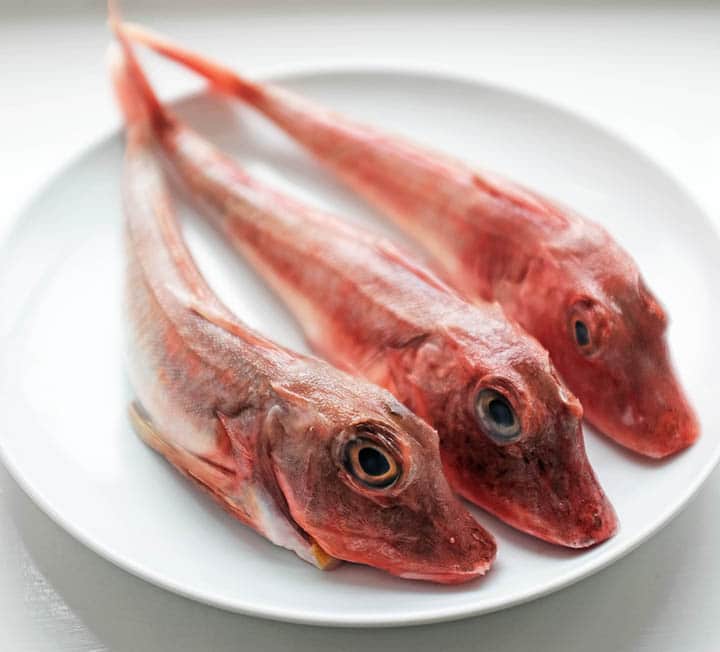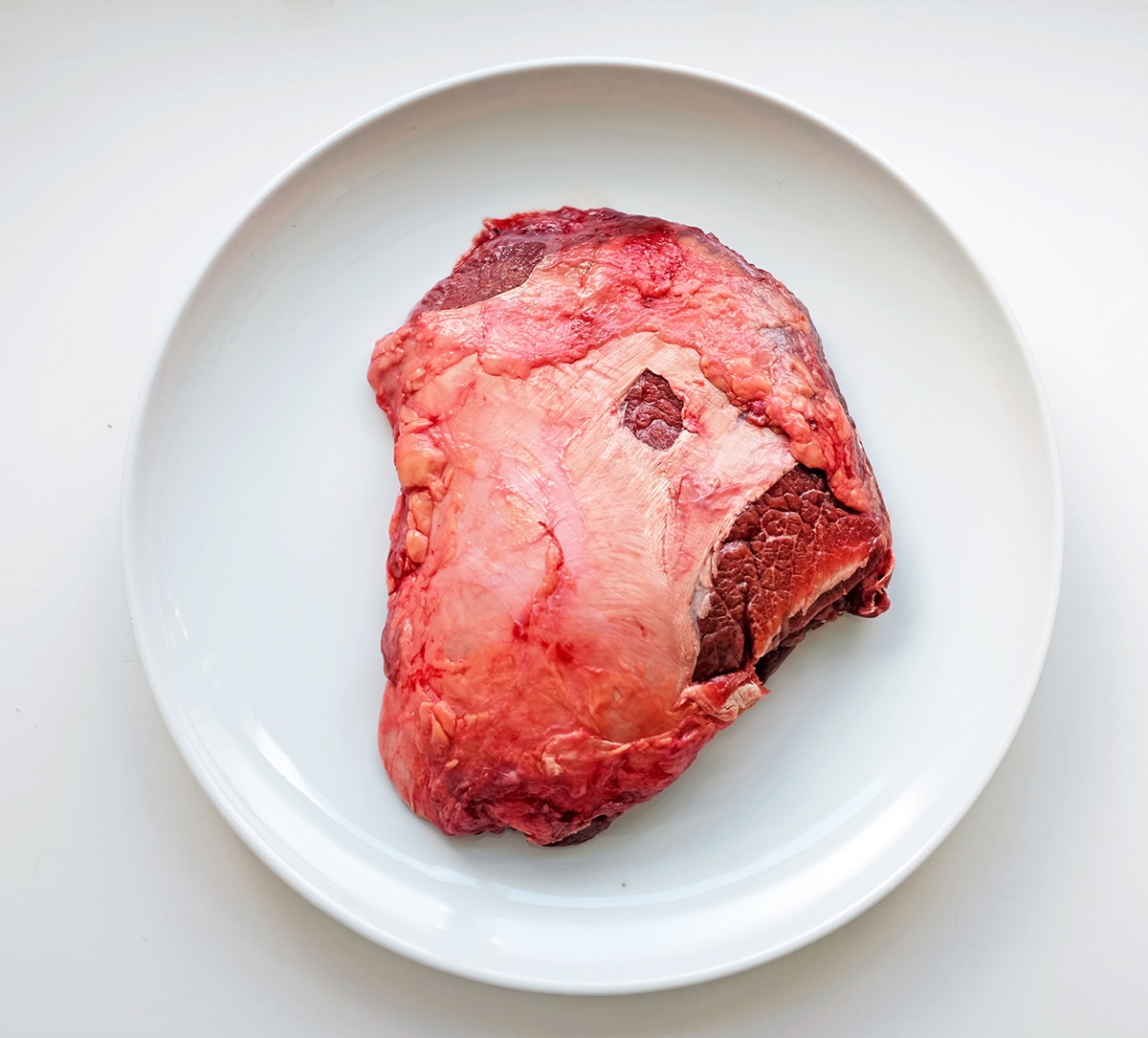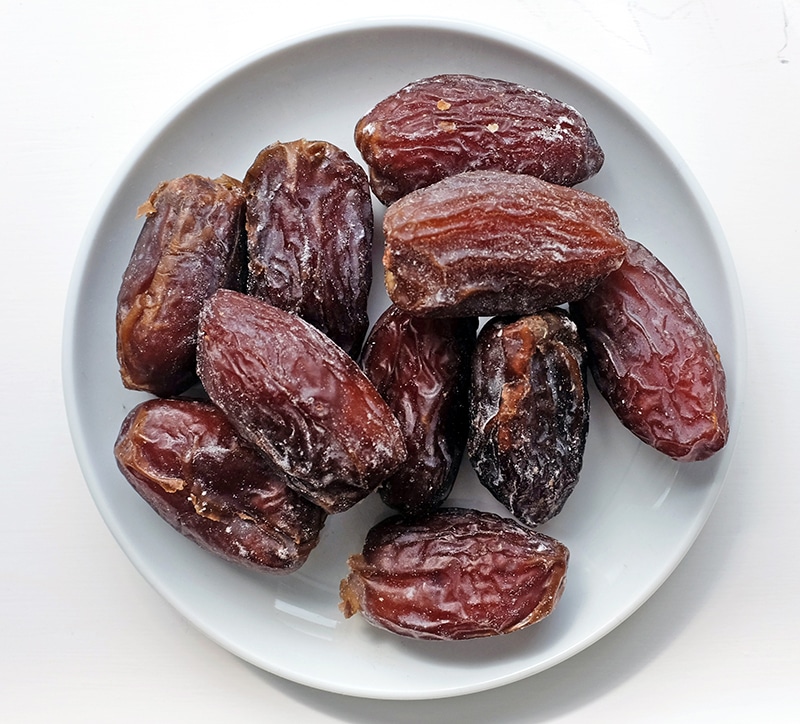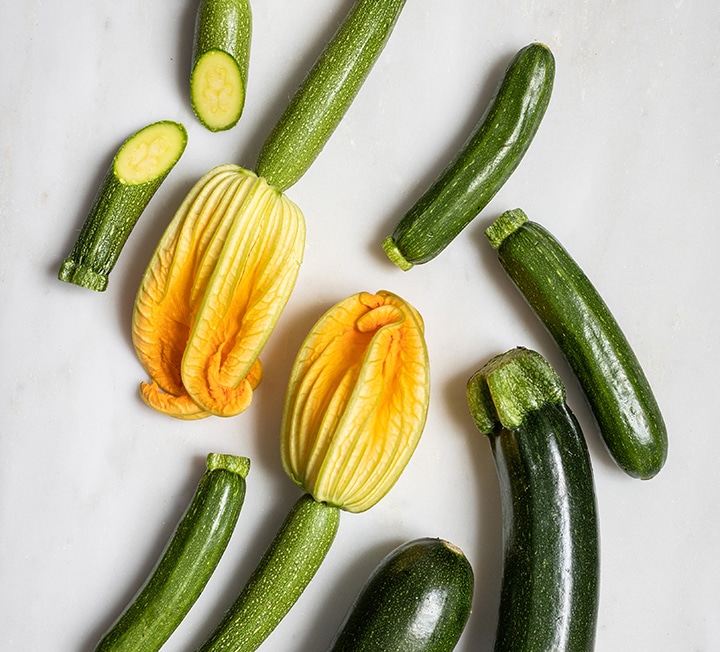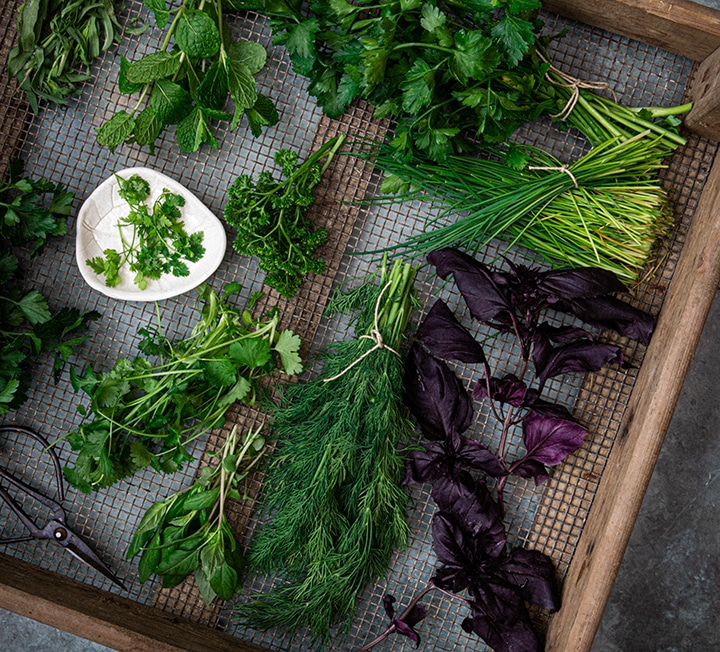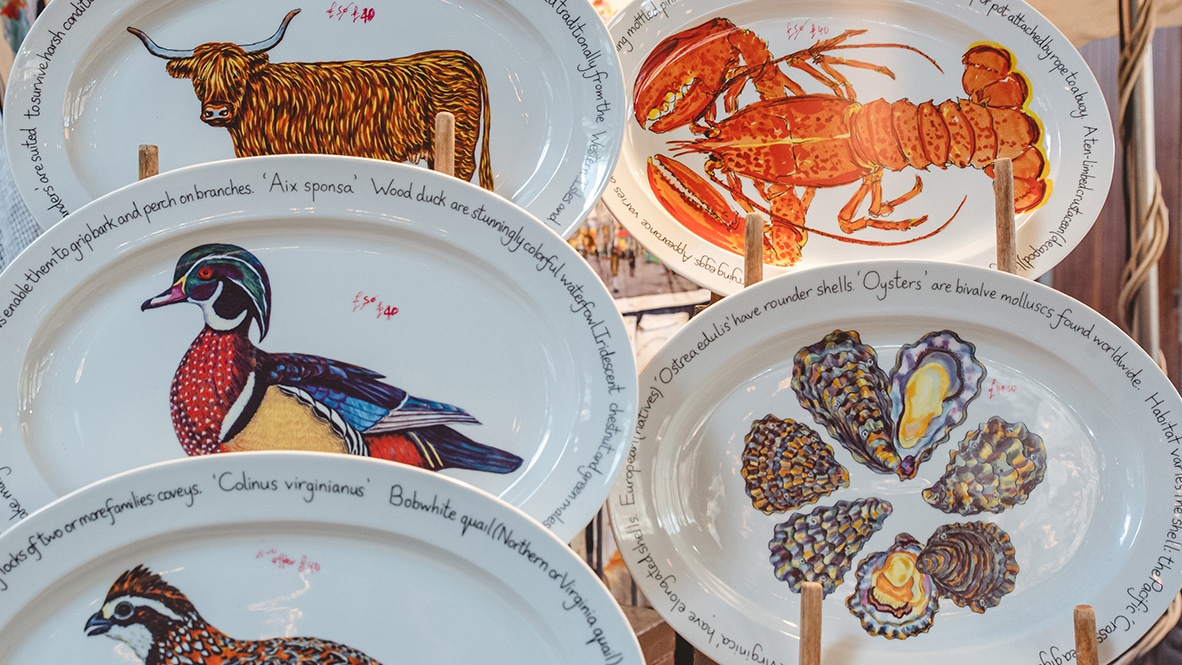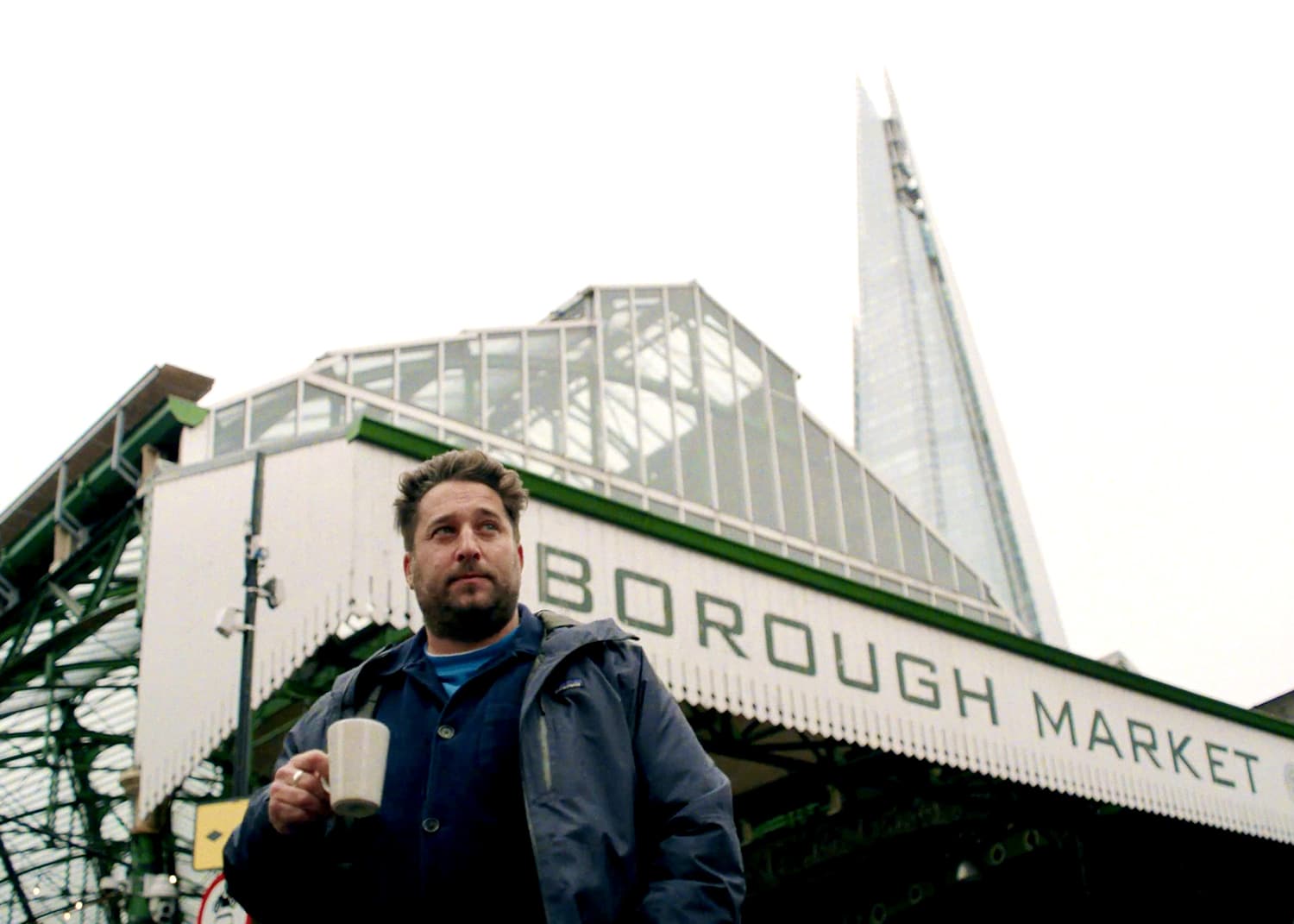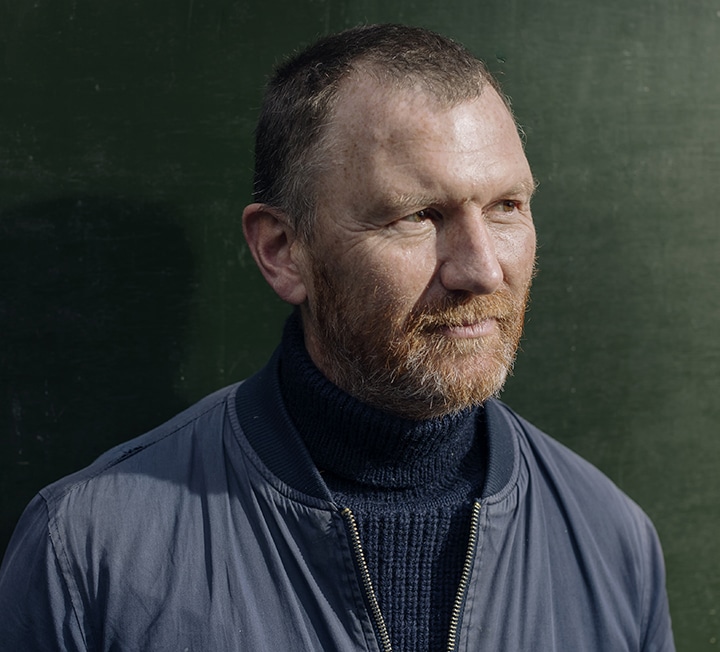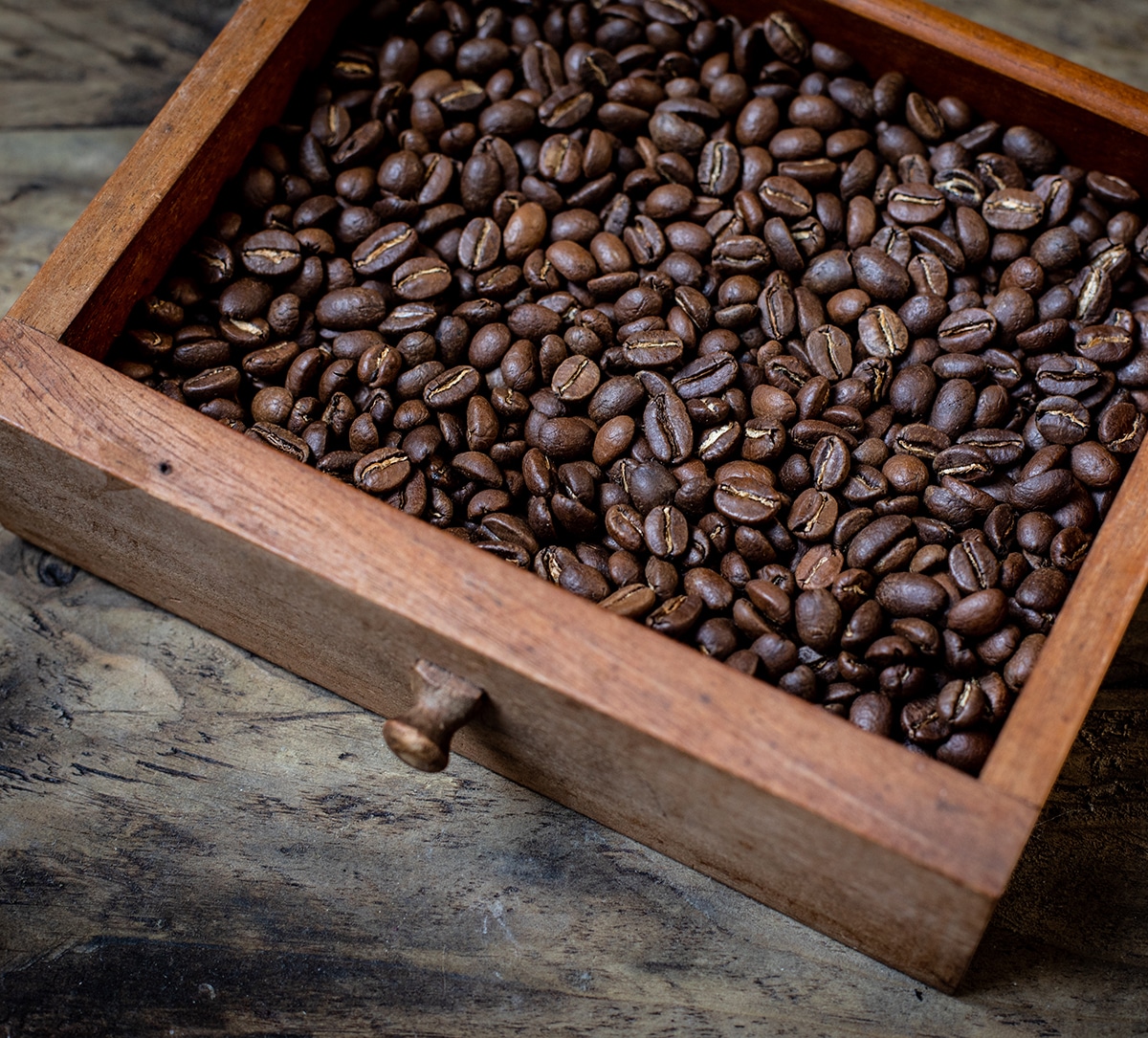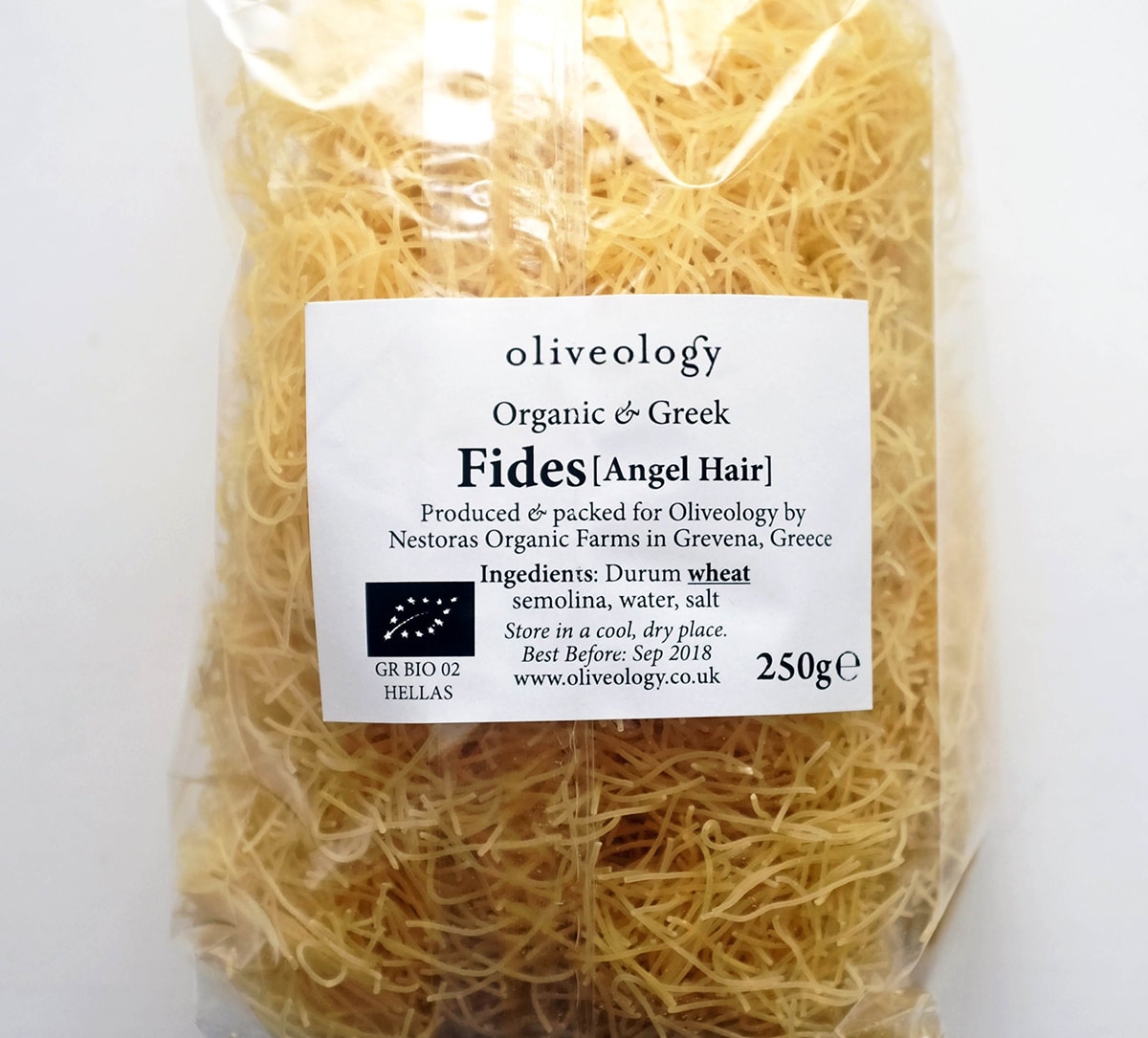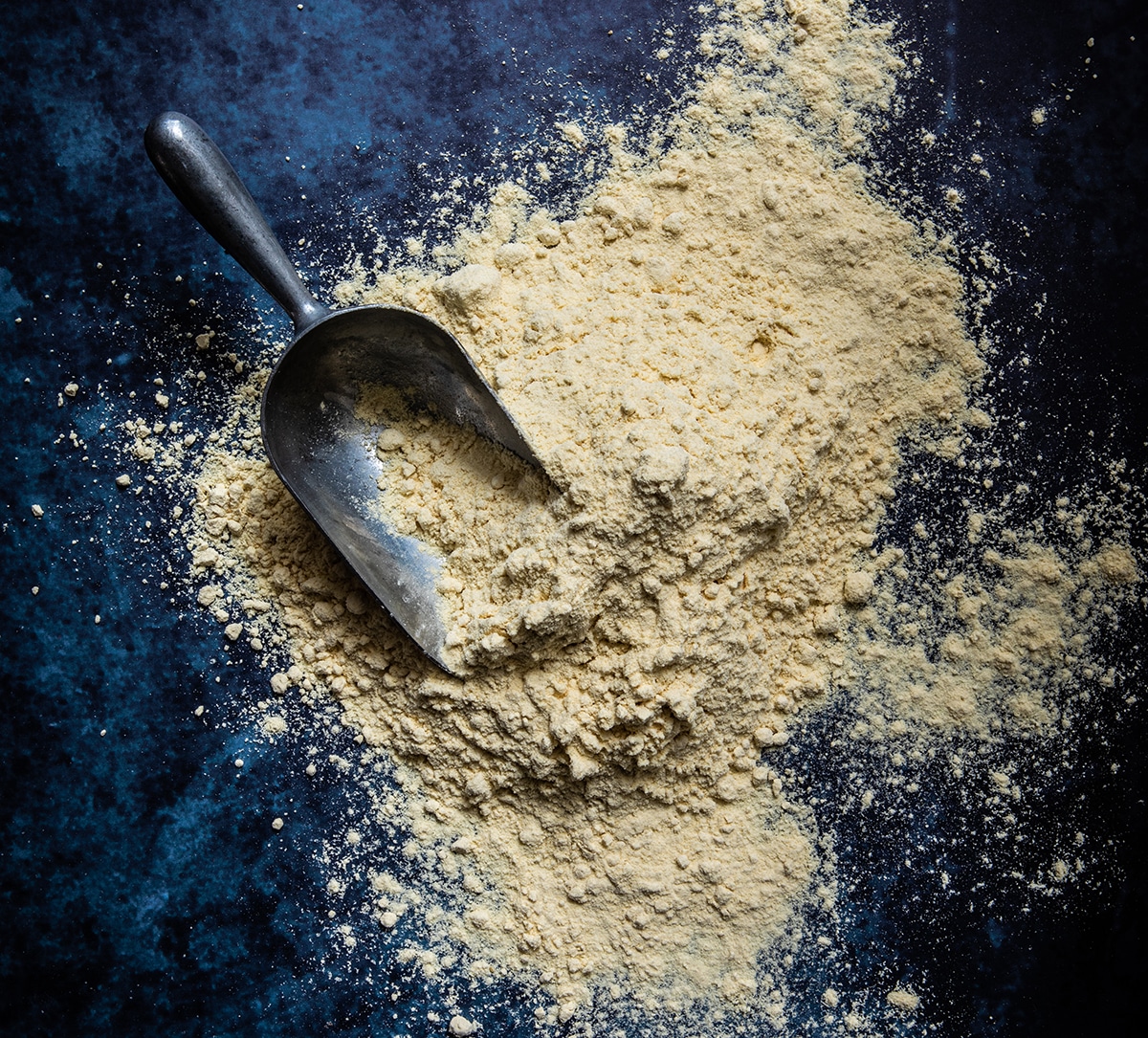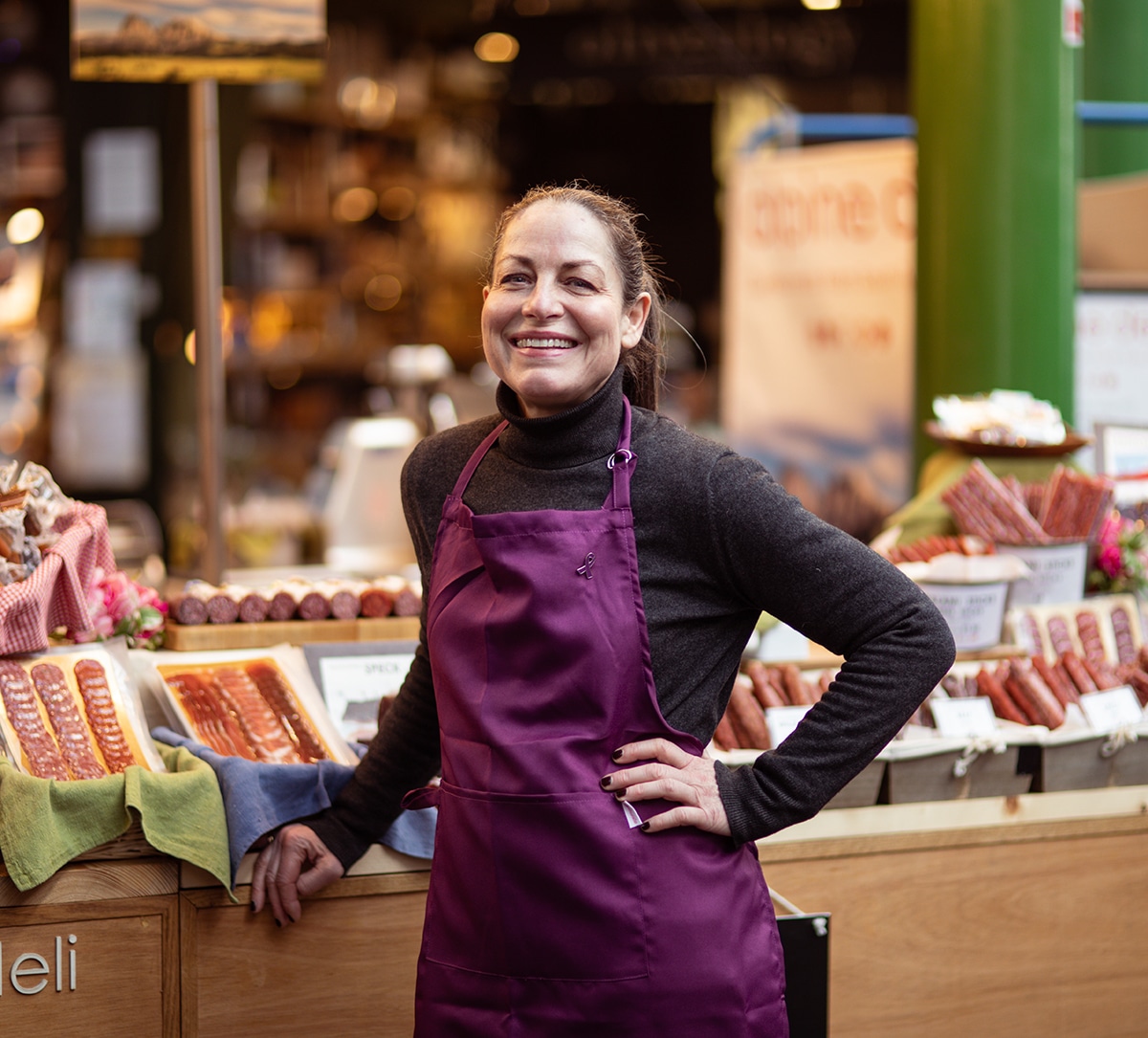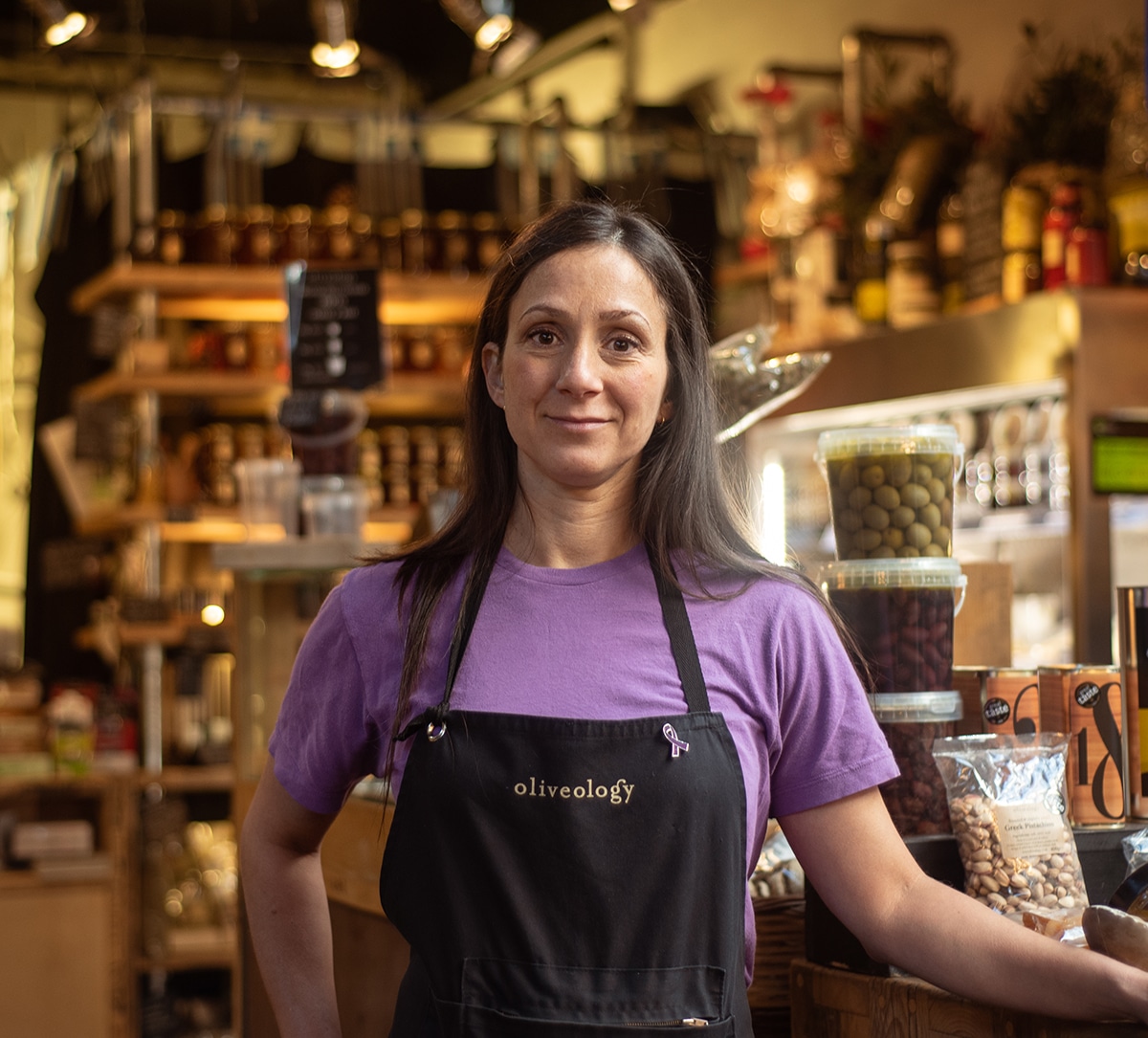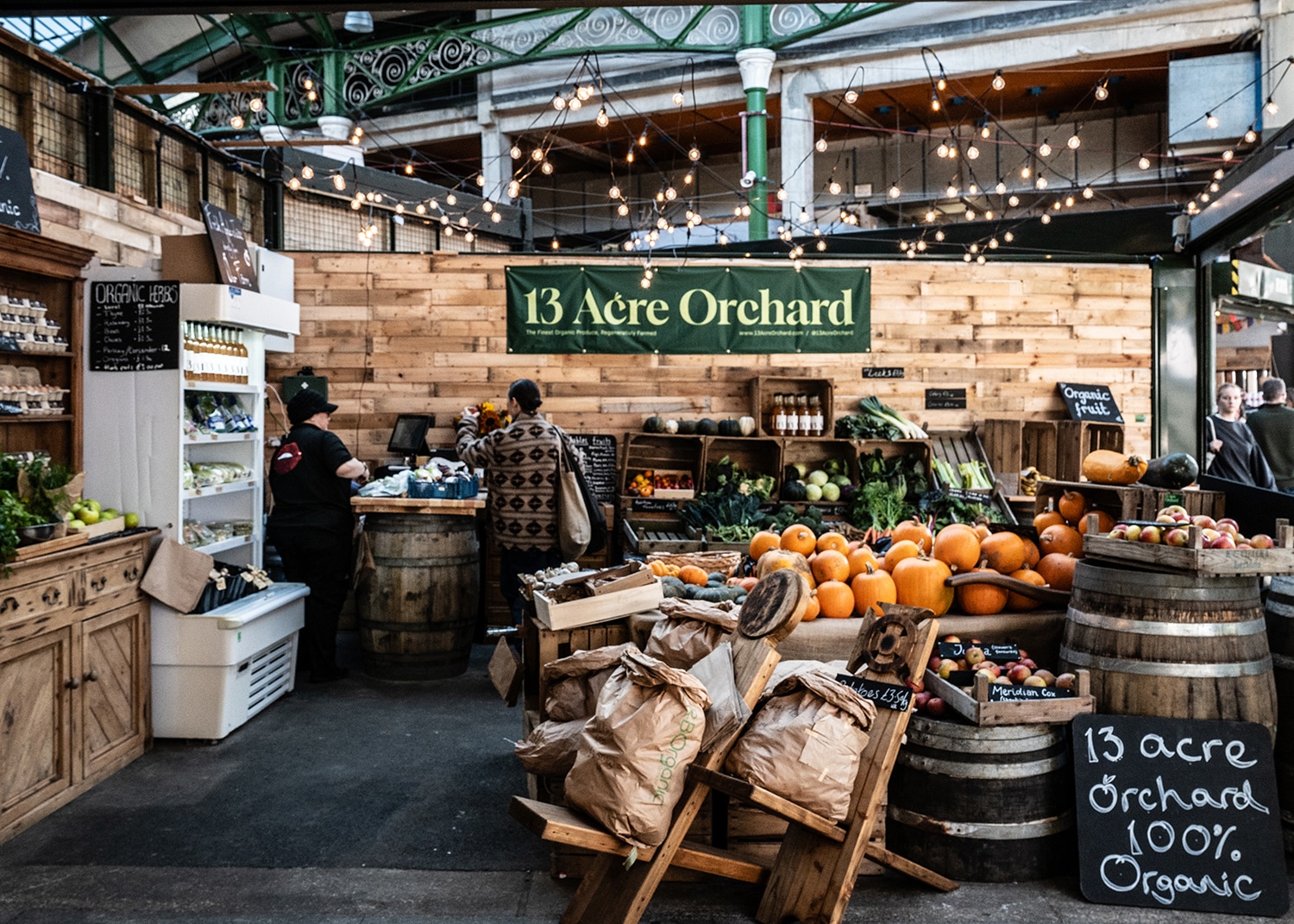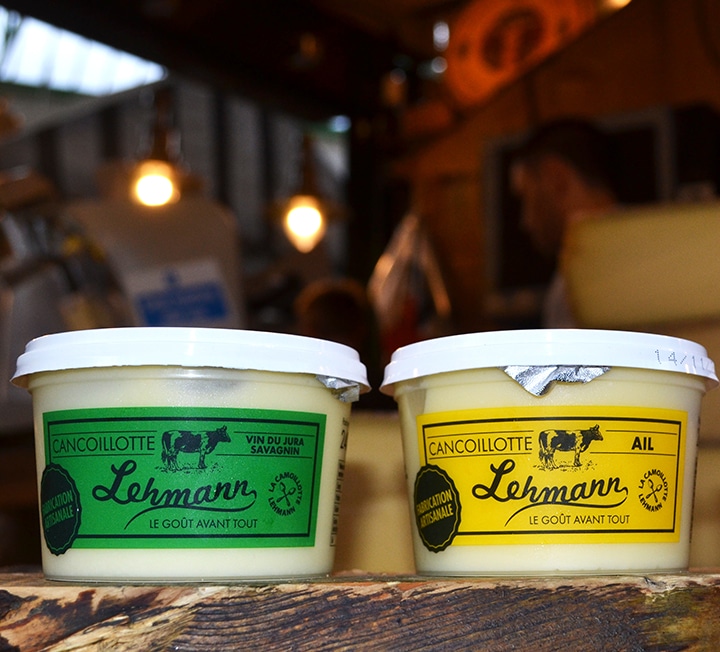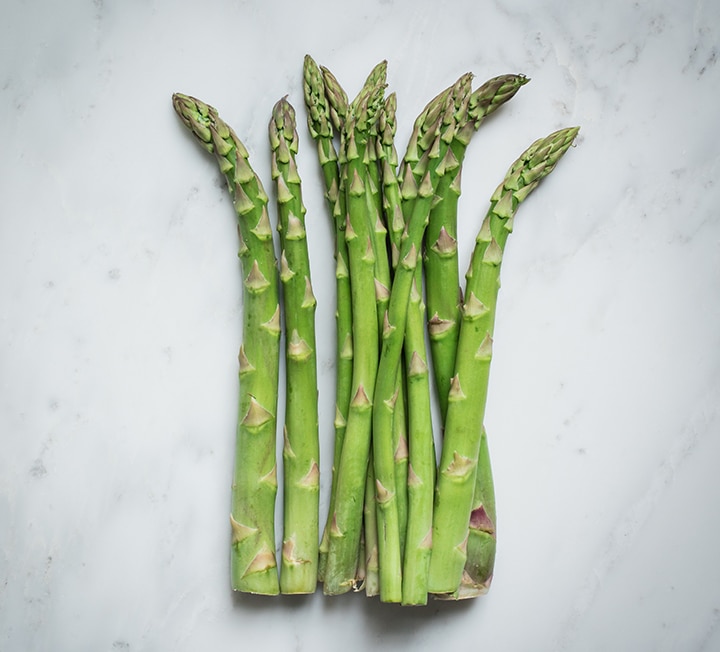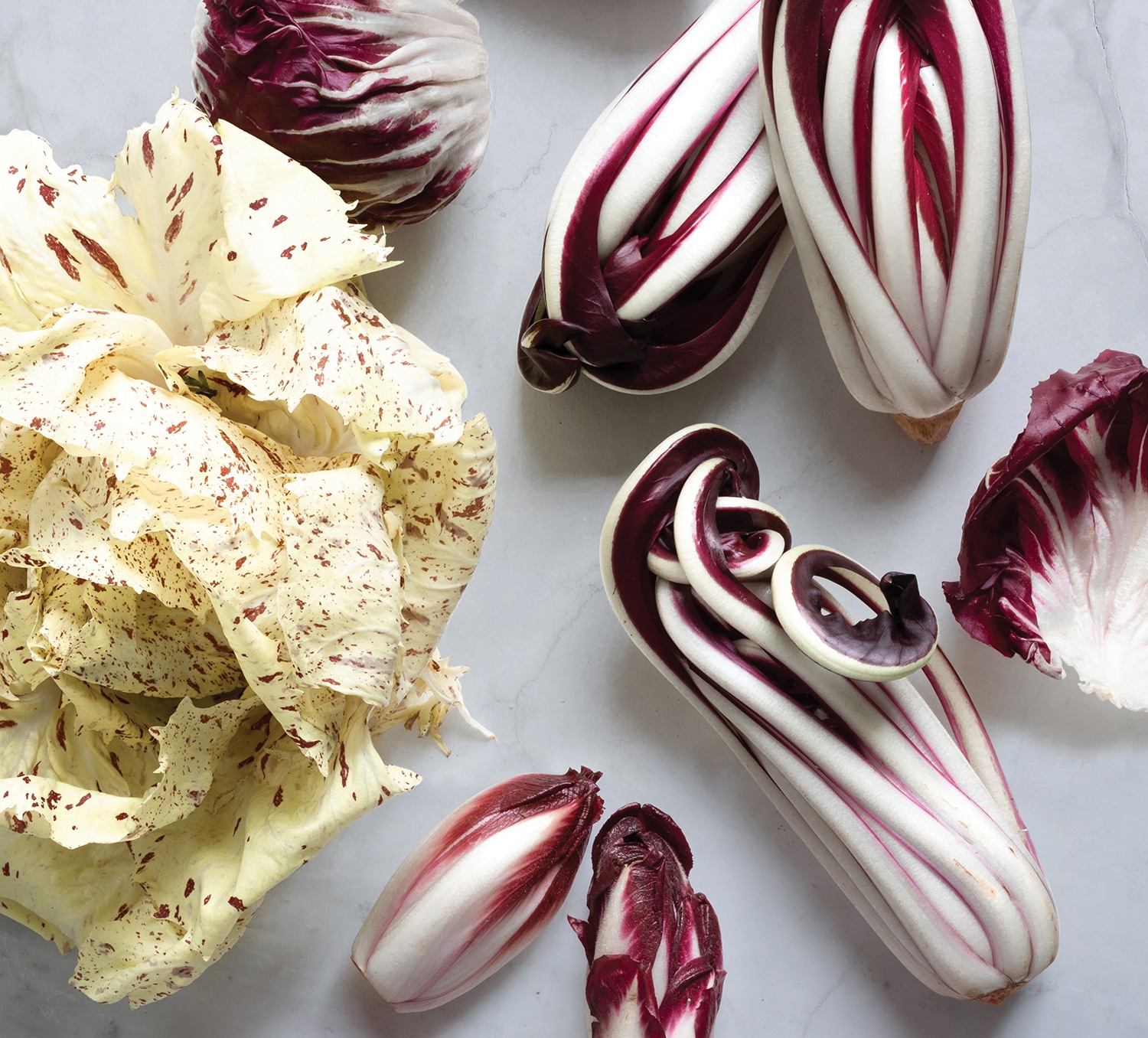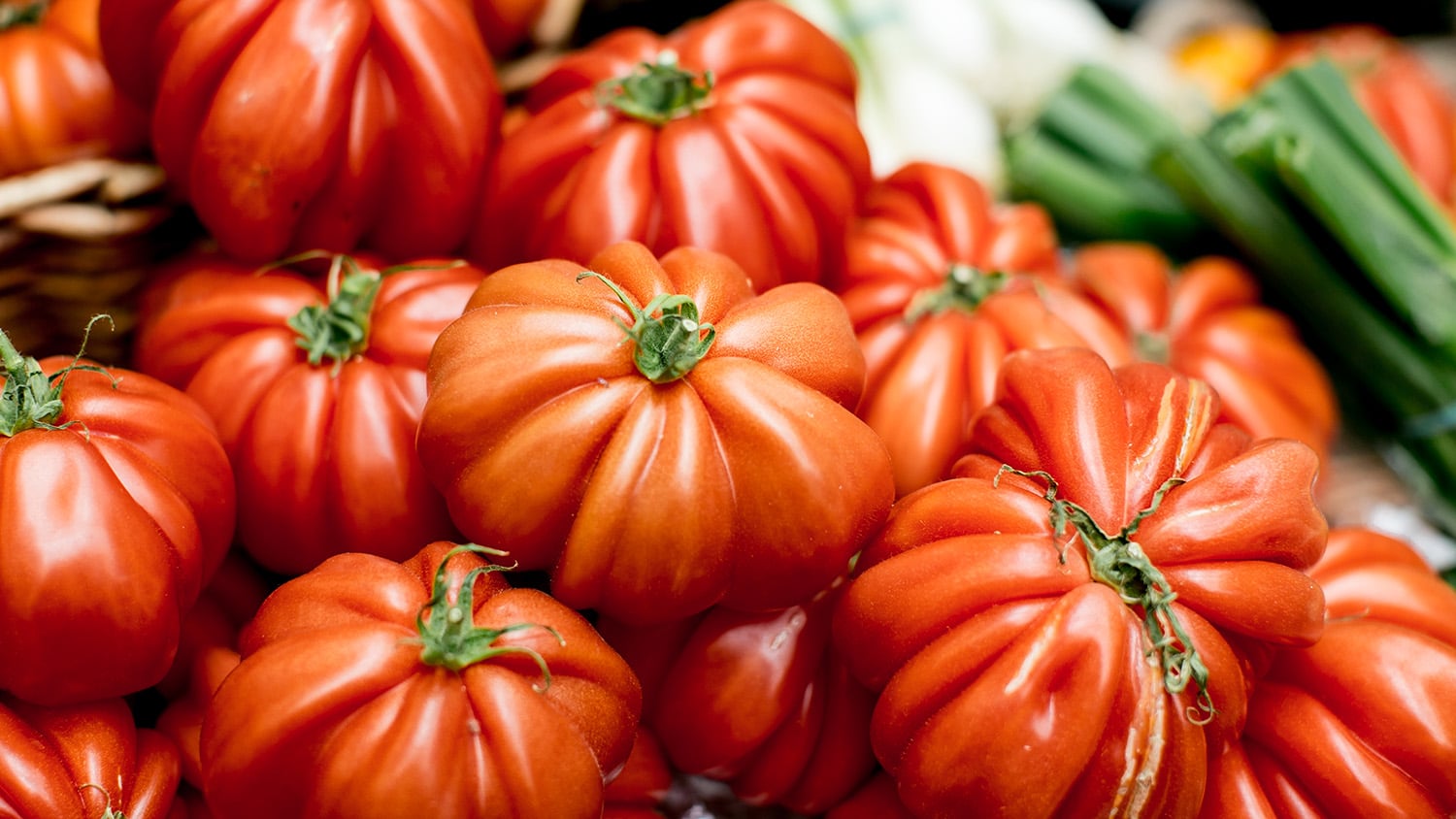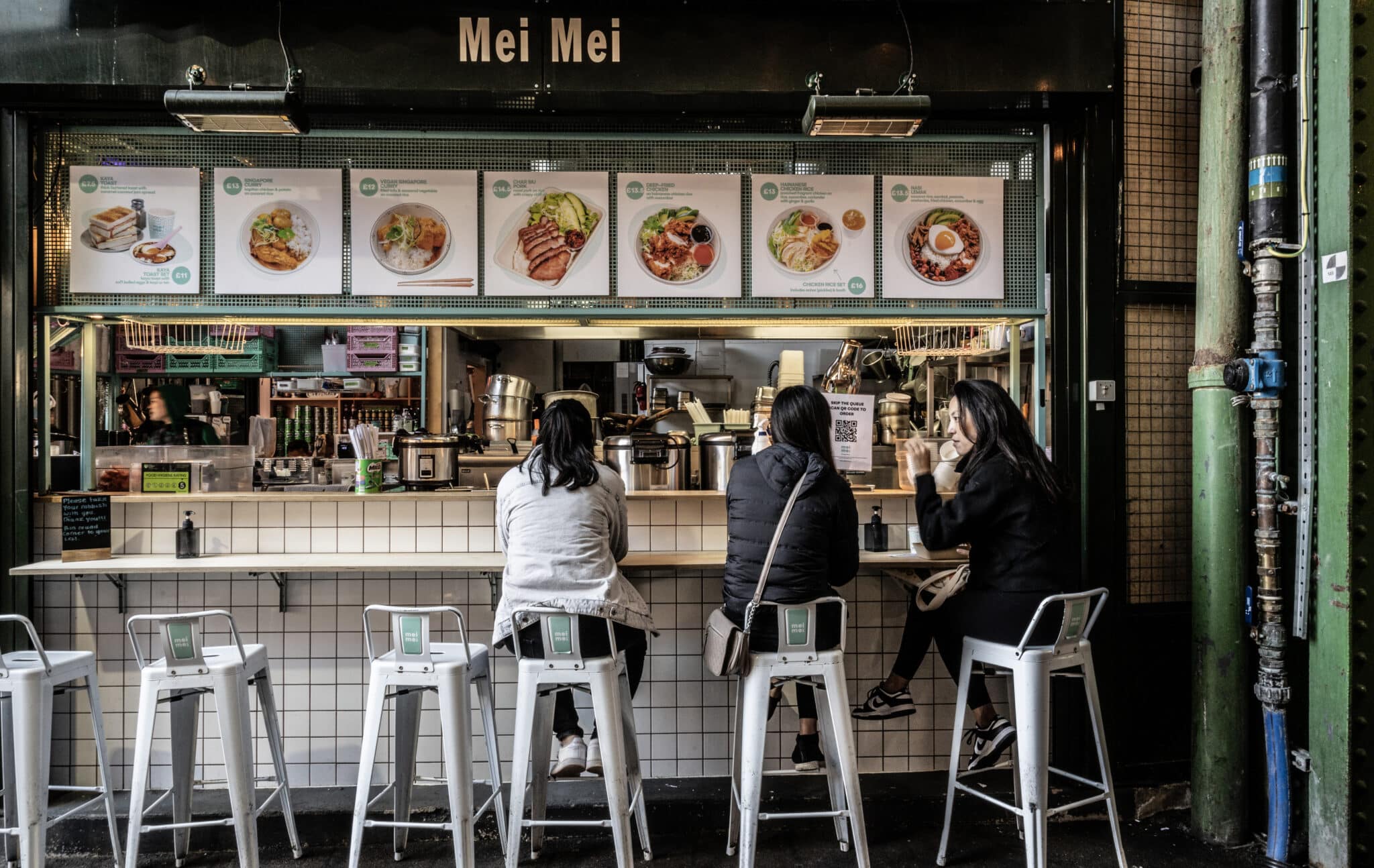Hidden charms: kohlrabi
Determined that you should never judge a book by its cover, Ed Smith explores the hidden charms of some of the Market’s less obviously alluring ingredients. This time: kohlrabi
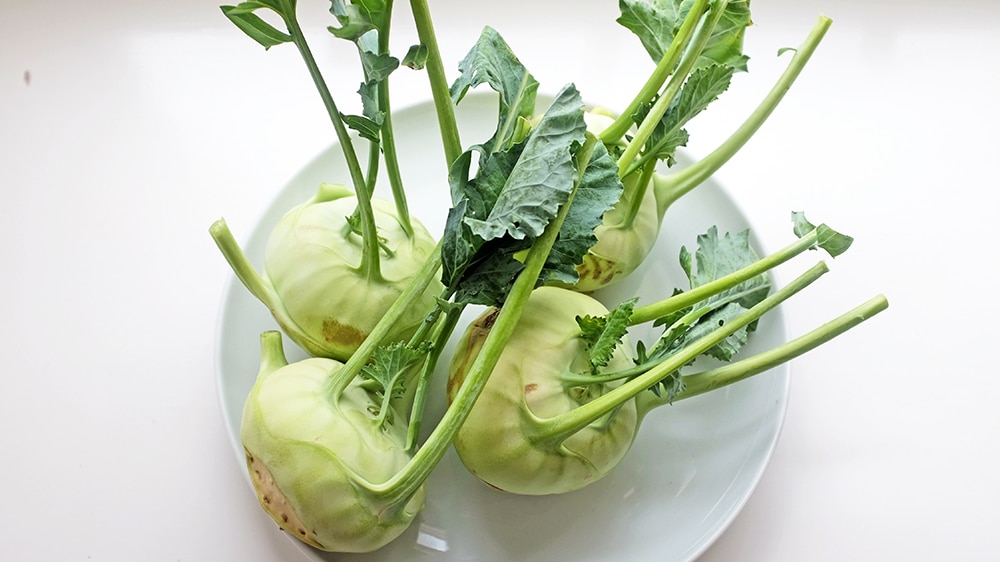

“PEEL BACK THAT SKIN AND YOU’VE A VEGETABLE YOU CAN COOK IN EVERY WAY YOU WOULD A ROOT LIKE A PARSNIP OR CELERIAC”
Image: Ed Smith
By my guestimation, kohlrabis landed in the UK about 20 years ago, like stout green sputniks or aliens from a Pixar movie sent to colonise our greengrocers. These weird looking vegetables are thick skinned and knobbly, sometimes with arms sprouting from them, and frankly pretty unapproachable.
Head across the Channel, down and left a bit, though, and you’ll find they’ve been a staple in our Germanic cousins’ diets for, well, pretty much ever. In fact, the etymology of kohlrabi (in German, ‘kohl’ means cabbage and ‘rabi’ is turnip) provides strong clues both to its heritage and what you might do with it.
Though it looks like a root vegetable, the kohlrabi is a brassica (like cabbage or broccoli), having been artificially bred as the swollen growth of a wild cabbage species. This helps explain the taste, which is similar to the stem part of broccoli – kind of sweet, a little bit peppery, a little bit cabbagey, and a little bit nothing at all.
In looks and texture, however, it is more like a turnip. Like turnips, kohlrabis have a fairly high water content, but are tough and almost impossibly crunchy and bitter when left raw and whole; you really wouldn’t want to bite into one as if it were an apple.
None of this is tempting you to buy and cook a kohlrabi yet, is it? Well, let’s start to turn this grubby stem into a flowering plant. Or at least something that’ll please the table come dinner time.
Kohlrabis are multi-talented. Peel back that skin and you’ve a vegetable you can cook in pretty much every way you would a root like a parsnip or celeriac. Dice it roughly, sweat in a little butter before pouring vegetable or chicken stock over the top, and before long you’ll be able to blitz it into a lovely autumnal soup.
You could add stilton, as you would to broccoli, apple as you might to parsnip, or cream and horseradish in the same way you might jazz up a bowl of blitzed beetroot. They roast fairly well, too, particularly when added to a mixed tray of squash and parsnips. I personally think they are perhaps a little too watery and bland to turn into a decent smash or purée.
Perhaps my favourite way to use a kohlrabi, however, is also a reminder of its versatility. For while kohlrabis do cook well, you can eat it raw if you slice it very thinly, ideally using a mandolin. At 1-2mm thick, kohlrabis are crisp and refreshing, the pepperiness is more pronounced, and are a wonderful carrier of citrus flavours and fresh herbs. A grand example is the kohlrabi and shrimp salad I once found on the menu at St John restaurant in Farringdon; I could eat it by the bucketful.
There’s more: if you salt thin slices of kohlrabi and wait for a few minutes, the slices become pliable, and can be artfully draped over other ingredients, or more usefully used as an edible holder for canapés, like vegetable tacos. Cut slices of mandolined kohlrabi into strips, and you can mix up a quick remoulade with yoghurt, mustard and parsley.
All of which means, I think, that this unappealing alien is, in fact, an amiable jack of all trades – a vegetable with which you should experiment if you’re not already well acquainted.
See Ed’s recipe for kohlrabi, spinach & smoked mackerel gratin.
The family stone
Rosie Birkett on the joyful memories and recipe ideas sparked by the arrival each summer of stone fruits
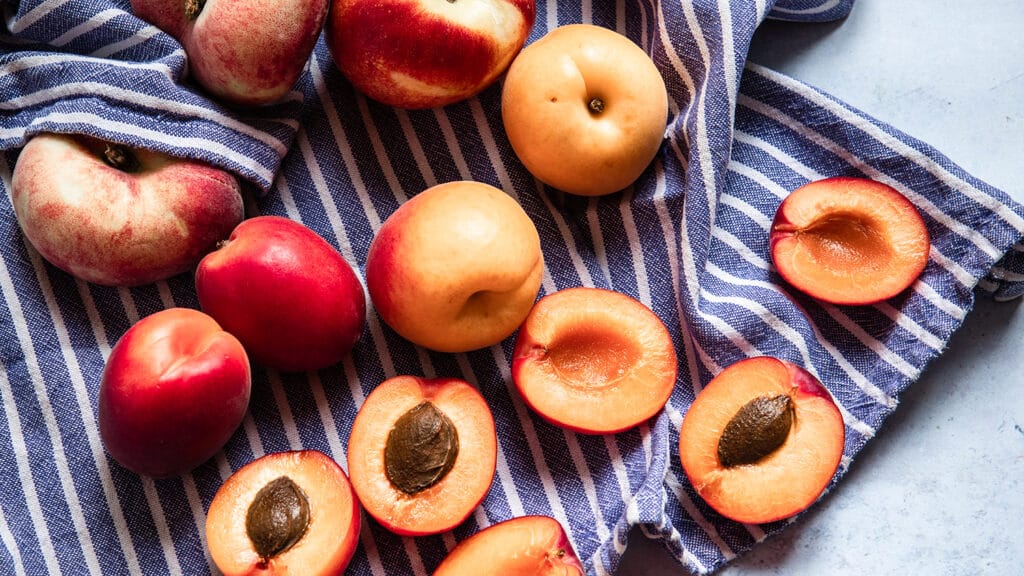

“THERE’S SOMETHING OUTRAGEOUSLY, ALMOST ILLICITLY GOOD ABOUT A WARM, FLESHY MOUTHFUL OF PEACH”
Images: Regula Ysewijn
A bag of ripe peaches heralds the summer. It summons flashbacks to moments suspended in time like peaches preserved in syrup: soporific garden lunches with bowls of peaches and cream; a lone, slightly squashed orb wrapped in kitchen roll at the bottom of my schoolbag – a sweet, longed-for, reviving joy after an ascetic hour of dreaded double maths.
I can be on the Walthamstow marshes, surrounded by nettles, fox poo and teenagers playing football and feel like I’m in the south of France if I’m biting into a perfectly plump peach – its honeyed juices dribbling shamelessly down my chin. There’s something outrageously, almost illicitly good about a fleshy mouthful of peach that’s been left to get warm-to-bursting in the sunshine, and if I’m hauling our meals to the park to escape our stifling London apartment in high summer, these make for a blissful dessert, just as they are.
Along with sublimely fragranced white peaches from France and Italy, flat peaches are a favourite. Slightly less fuzzy than their rounder siblings, their headily perfumed, pale flesh has an extra sweet flavour with a whiff of almond. Originally grown in China – where the peach originated – from a mutation of the common peach, they have become popular across Europe in the last few decades, but make sure you look out for the organic, Spanish-grown versions rather than the sad, plastic-wrapped imports from further afield. One of my favourite ways to use them is baking them into a light, almondy upside-down cake with cherries and basil. The soft fruit keeps the cake moist, sort of self-saucing it, while the basil lends a fragrant edge and the flaked almonds an irresistible crunch. With the addition of a luscious spoonful of clotted cream or creme fraiche (Neal’s Yard Dairy, I’m looking at you), it’s everything I want in a cake.
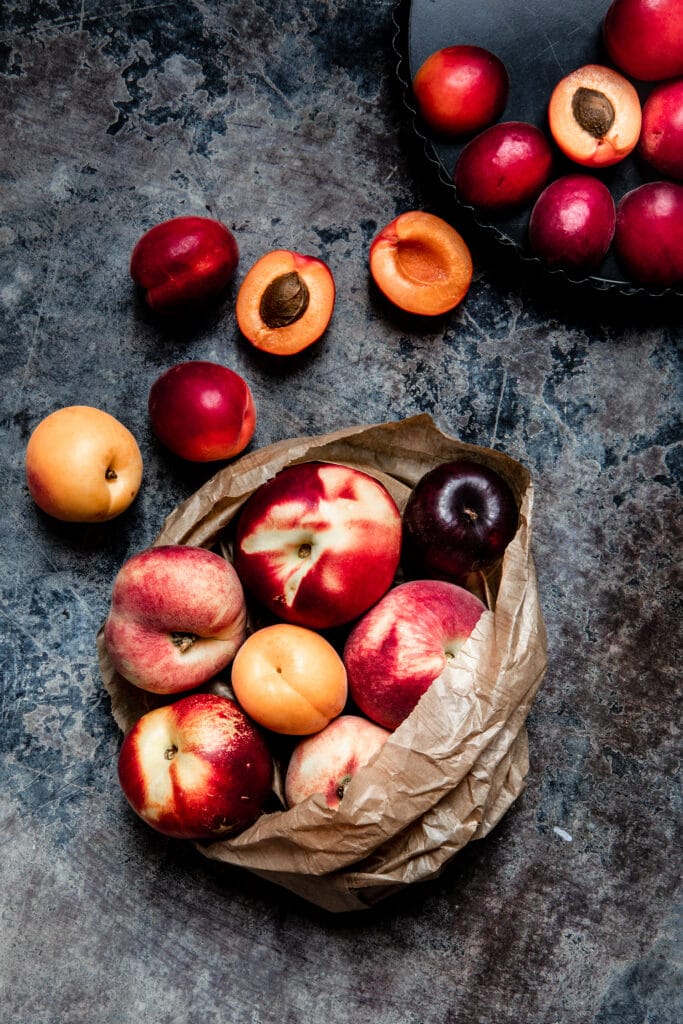
Almonds and peaches are a happy combination much-loved by the Italians, particularly in the classic dish of ‘pesche ripiene’, or stuffed peaches. The version from my battered, browned copy of Elizabeth David’s Italian Food has been a staple at our kitchen table for years. It calls for six yellow peaches, three ounces of crushed macaroons (in the 1950s, this meant amaretti biscuits), one egg yolk, two tablespoons of sugar and an ounce of butter. You cut the peaches in half, scoop out the stones and mix a little of the pulp with the other ingredients, then stuff it back into the peach, baking them in a buttered dish for around half an hour. I’ve made several versions over the years, replacing the amaretti with flaked almonds or the egg yolk with more butter, and (sorry Elizabeth) adding a splash of sweet white wine, prosecco or rosé to proceedings when the mood’s taken me.
If you’ve not tried before, have a go at pickling peaches. When left to bathe in a sweet solution of good quality white wine vinegar, sugar, fennel seeds and peppercorns (or whichever aromatics you might fancy), they take on an incredible complexity and depth of flavour, and a balanced acidity that makes a wonderful accompaniment for fatty, grilled, meaty things like pork chops or great hunks of hard, nutty cheese such as comte or manchego. The skins will wrinkle with time but don’t worry about that – you can just peel them off.
In a similar vein, peaches are marvellous in substantial salads. I love them paired with the peppery, slightly citrussy flavour of celery leaves, tossed with a sharp goat’s curd, sourdough croutons and prosciutto and strewn with anise herbs like chervil or tarragon. At a late-summer supperclub a few years ago, I served a version of this with Cornish pork belly that had been slow braised in whey and then crisped up under a hot grill. There’s something magical about crispy pork crackling eaten with yielding peachy flesh.
Apricots, with their smooth, deep golden skins blushing hot pink, are another wonder of the warmer months. If the flesh is mealy and the flavour one-note, they can underwhelm – but even these can be rescued with a gentle roasting in the oven or caramelising in the pan, or by poaching in a wine-based syrup. I like to poach whole apricots in sweetened rosé with lemon zest and fresh lavender – the floral, herbaceous notes of the purple flowers add a pleasing complexity, and the poaching concentrates the flavour. I use these in all manner of desserts: baked into tarts, or eaten with whipped cream cut with a little natural yoghurt and topped with crushed shortbread and chopped nuts.
Very good apricots have a unique sharpness that makes them ideal for patisserie. Paired with sweet, vivid green pistachio frangipane, they really sing. I’ve made various ensembles, from blondies to more classical tarts with flaky, buttery pastry. My absolute favourite, though, is to bake them into a biscuity, hazelnut pastry tart shell with a sharp, muscovado-laced buttermilk filling that retains an irresistible wobble once baked, dressing the fruit with tangy, silky custard upon slicing.
Growing up in Kent, plums were the fruit that defined the late summers of my childhood. I still remember my unexpected delight at biting into the dusky reddish-purple skin of my dad’s homegrown plums to find something juicy, sweet and sharp – better than anything I could have bought from the school tuck shop (and that’s saying something, for I was its best customer, loading up on Wham bars and pink shrimps daily – it’s a miracle I’ve still got teeth). In recent years, I’ve become partial to greengages, enjoying their fresh, tangy flesh in dairy-rich desserts and salads with peppery leaves, or in my favourite breakfast compote, made with whole almonds or cobnuts, ideal on hot buttered crumpets or mounds of good yoghurt.
Small wild plums, similar to mirabelles, grow copiously on the marshes where I live. I’ve roasted pork on top of them so that its juices mingle with their blistered skins. I’ve even had a go at salt-fermenting some, inspired by the Japanese delicacy of umeboshi. The resulting shrivelled, concentrated, wonderfully sour fruits were a revelation, so I served them in a dashi-like broth at my residency at Carousel in Marylebone, which I had the unplanned audacity to dish up to some real life Japanese people, visiting from Tokyo. Thankfully, they approved of my approximation – or else were just too polite to let on.
Discover more
Q&A: Steven Brown
The farmer responsible for 13 Acre Orchard on regenerative systems, eliminating waste and the support provided by greedy chickens
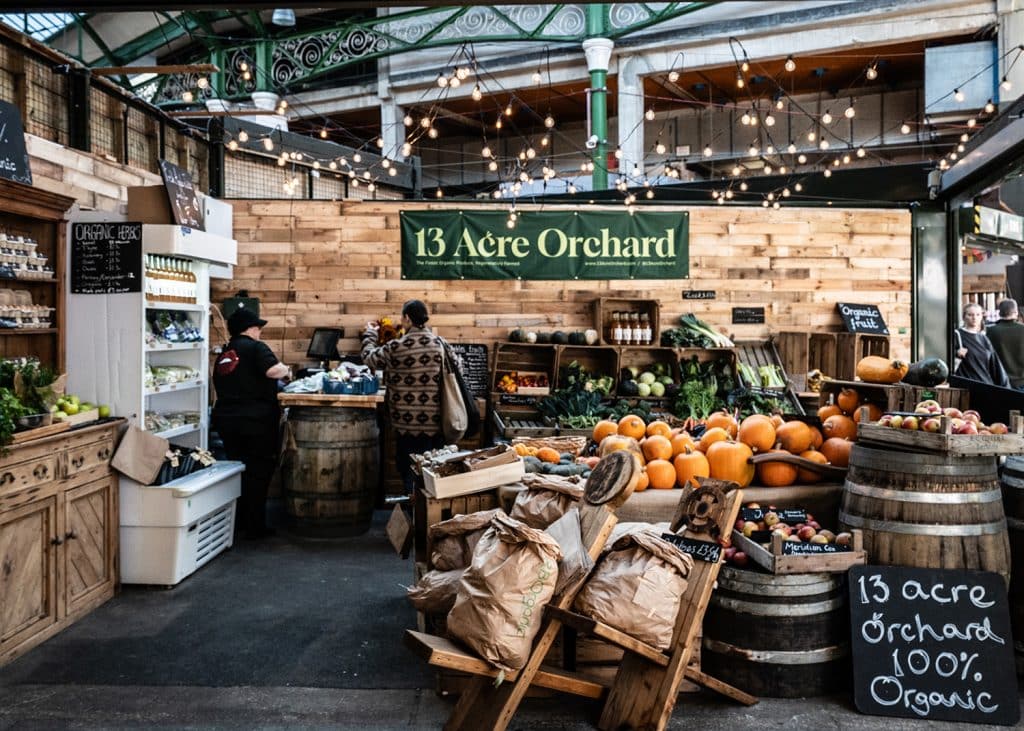

“EVERYTHING GROWS BY ITSELF. MY JOB IS TO MITIGATE ANY ISSUES THAT MIGHT CAUSE PROBLEMS FOR THAT GROWTH”
Interview: Mark Riddaway
Most farmers are born to the role, their roots dug in deep across the generations. Not Steven Brown. “I never really thought I’d be doing this,” he says. “I just always wanted to spend my life outside. Long story short, it turned out the way I could spend the most time outside was through farming.” What began as a series of outdoor jobs became a genuine vocation after Steven found work on a permaculture farm – an approach to food production informed by the natural interplay that allows complex, diverse ecosystems to thrive in the wild. “You look around and there are thousands of trees, wildflowers, shrubs and crops, all squeezed together into this tiny space,” he says. “I started to read a lot about the positive influence this type of farming can have. It really helped shape the way I see the world.”
Steven’s evolving worldview is now being applied in a small but systematic way at 13 Acre Orchard, a beautiful plantation of fruit trees and vegetable patches on a farm close to Saffron Walden in Essex. For the past three years, almost entirely unaided, he has been slowly transforming this patch of land into a regenerative farming system, the produce from which he sells at the new 13 Acre Orchard stand at Borough Market.

How did you come to be running 13 Acre Orchard?
I grew up in this area. A friend of mine introduced me to Laura, who owns the farm. She’d just had a son, and the workload involved in running the orchard was proving too much – even without having children, it’s a lot. The first time we met, I spent a couple of hours walking around the farm while she explained that was involved, and I was thinking, she’s got to be nuts, this is ridiculous, how are you supposed to do all this? But I still came back the next week to have another look. I did a bit of research, I made the visit a few times, and every time I came here it felt a bit more realistic – a big challenge, but possible. I thought, let’s just take the world as it is and see what happens. I’d worked with trees before at the other permaculture place, but nothing on this scale. It’s been non-stop since then. I’ve been working flat out, all the while trying to figure out how to do this, how to improve the land.
You describe what you do at 13 Acre Orchard as ‘regenerative’ farming. In simple terms, what does that mean?
It starts with the idea that a farmer is there to look after the land. In a regenerative structure, the land you’re looking after will improve as you’re farming. As you grow your vegetables or raise your livestock, or whatever it is you’re doing, you’re putting more carbon into the soil, you’re looking at how water moves through the landscape, you’re creating more wildflowers, more insects are coming, there’s a growing abundance of everything, from microscopic life up to bigger things like birds. There are lots of different elements you can add in, but the main thing I’m concentrating on is building the soil health and depth, creating biodiversity on a microscopic level – more bacteria and fungi, microarthropods and macroarthropods. If you can feed those things, they in turn feed the trees, so you don’t need the fertilisers. That process also results in the carbon sequestering that people talk about us needing more of. You’re sticking carbon straight in the ground, and that’s helping the trees to be healthier as well.
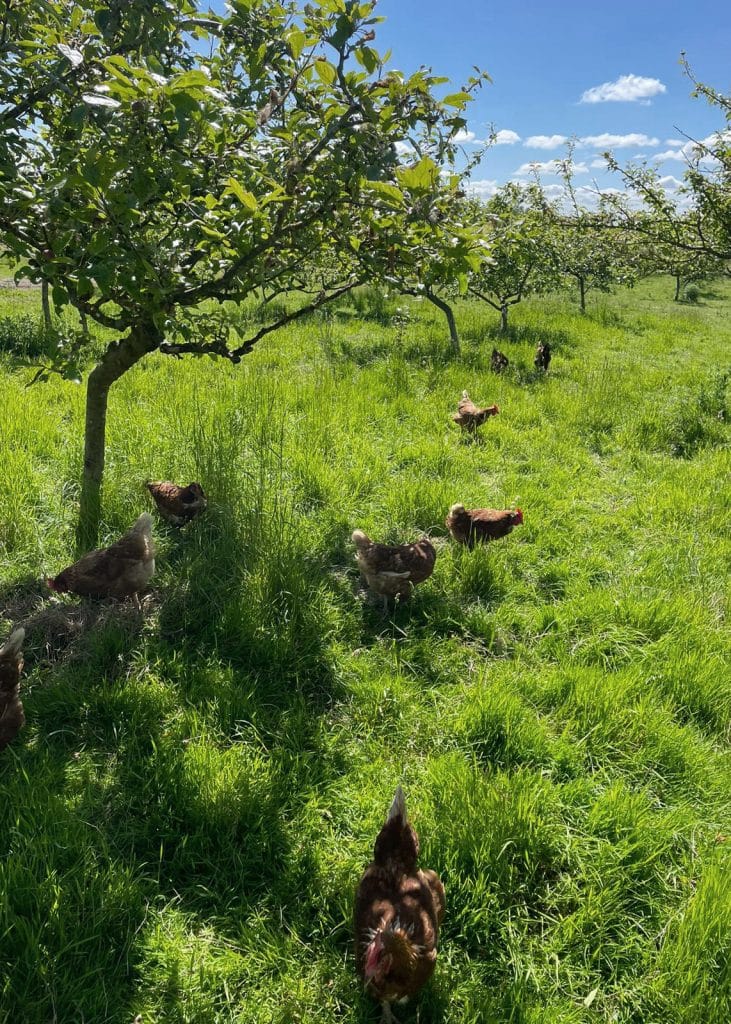
So, you’re intervening in those natural cycles far less than a conventional farmer would do…
Yes, it grows by itself. Your job as the farmer is to mitigate any issues that might cause problems for that growth. Compaction in the soil is the big one. Too much water can also cause problems, as can water in the wrong places. To mitigate that, putting a pond into the landscape can bring all the water together while also creating an environment which is beneficial for different plants, so you get more pond life and healthier trees.
What are you currently growing at 13 Acre Orchard?
Mostly, it’s apples, plums and pears. We have chickens for eggs – Laura looks after all the chickens still. They live under the apple trees and eat lots of the insects that would normally cause problems to the apples. They also produce plenty of natural fertiliser.
We also have a small vegetable garden, which we’re looking to expand, and we’re going to possibly do some flowers very soon too. My long-term plan is to incorporate a lot more growth within the orchard in a way that benefits the trees. Rhubarb, for example, grows well under fruit trees. It will come up at the beginning of the season and grow up big and help the trees to grow. Later in the year I’ll grow another crop within the same space. There’s a world of possibilities – it’s a bit overwhelming at times, but all very, very exciting.
What do you do to ensure that as little as possible is wasted?
We juice the apples that nobody would want to buy. After extracting the juice, you’re left with a pulp, and we use that pulp to make fruit jelly. My mum makes all the fruit jellies and jams – she’s been doing that her whole life, basically. Anything we can’t use gets made into compost, which goes into the vegetable garden and around the trees. Any cardboard waste is also getting incorporated into the compost. The idea is that there is no waste anywhere along the way. At some point in the future, hopefully we’ll be able to use potato starch as pallet wrap – at that point, I don’t think we would have any waste at, because that’ll go into compost as well. It can be done!
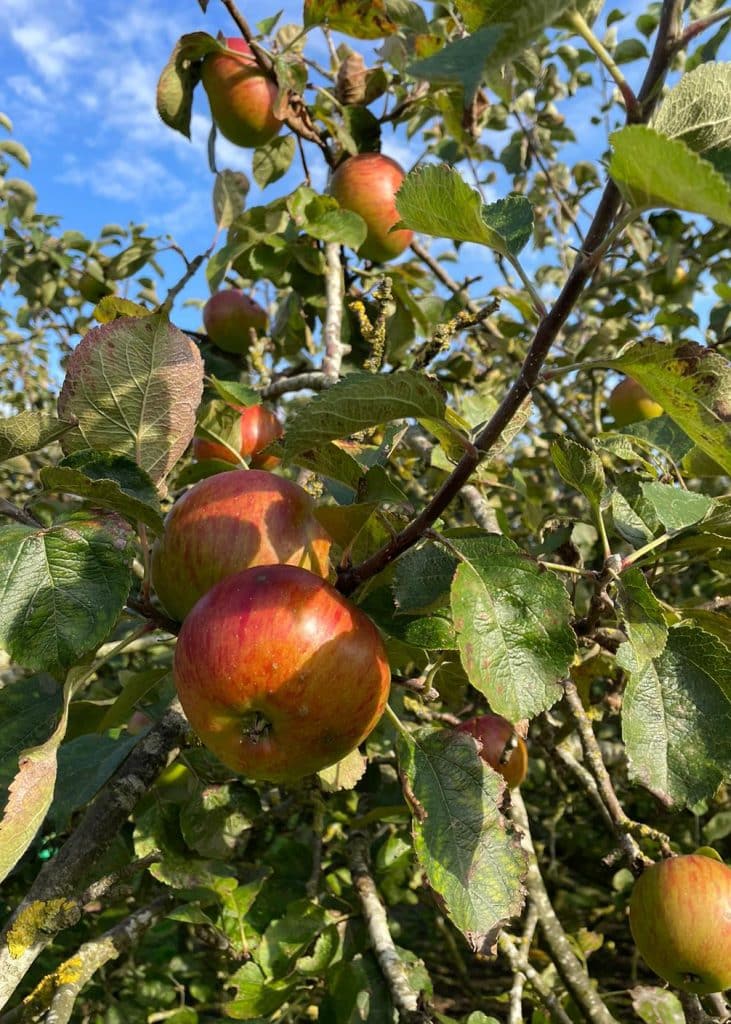
You’re also selling produce sourced from other farms. What’s the nature of that relationship?
So, the idea is to build a network of farms that share a similar way of doing things – regenerative, organic, however you want to label it. Ultimately, it’s people growing good food in a positive way. For example, there’s one guy that’s growing peas, but he’s growing wild flowers mixed into the crop. So, you’ve got a field of peas, but with an under-layer of wild flowers. Across a whole field, you end up with millions of extra flowers, and there are lots more insects because of that. We’re looking for people like him who are doing interesting things with farming, we’re buying stuff from them and putting it out into central London. We want this to be the main hub for regenerative agriculture in London.
What can we look forward to seeing on the stand in the coming months?
There’ll still be lots of apples. There’s going to be plenty of squash. There are mushrooms, carrots, beetroot. Brussels sprouts will be coming in, all the Christmas stuff. We’re getting everything ready for Christmas now. We’re trying to work the shop so it’s completely seasonal. There’s still loads of food around now; the challenge will be, at certain times of the year, that there isn’t much growing. But that’s tomorrow’s problem!
Do you enjoy selling food direct to the public through markets?
Yes, it’s good fun. Whether or not people like what you’re doing, you get such a quick reaction. Luckily for me, more people like it than don’t, so they keep coming back each week. We see lots of the same faces, week in, week out, which is nice. It’s like holding 200 brief conversations simultaneously.
By the standards of modern farming, yours is a very small operation. Are the things you do to support the environment replicable on a larger scale?
Yes, regenerative farming is definitely something you can do in a way that would look from the outside more like traditional agriculture – like standard fields of crops. There is a tension in some people’s minds between modern farming and the environment, but I think you can combine the two. To give the devil its due, the farmers who are doing that large-scale monocropping are producing huge amounts of food, which simply wasn’t possible before. I think it’s entirely feasible that you can combine these two schools of thought so you’re getting the best of both worlds. Regenerative farming doesn’t have to be limited to little orchards like this.
Cupboard love: pistachios
Ed Smith on why pistachio nuts are an essential component of his kitchen cupboard
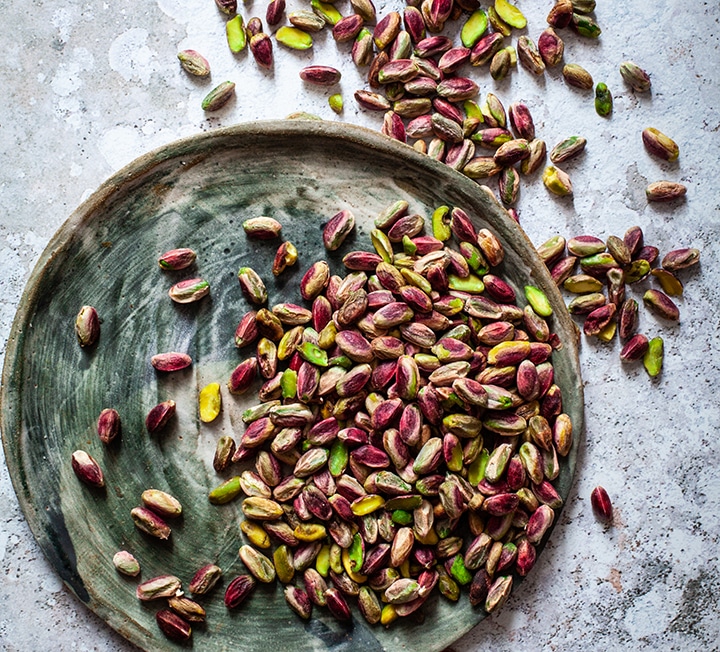

“YES, THEY’RE A TEMPTING BAR SNACK, BUT THE POTENTIAL OF PISTACHIOS GOES FAR BEYOND THAT OF A DRINKING PARTNER”
Image: Regula Ysewijn
I didn’t grow up thinking pistachios were something we should cook with. Which is not to say I don’t have fond memories of them. In fact, I have strong recollections of Tuesday night binges – the time of the week when my dad sat down to work through his accounts, with a bottle of red and some salty bites to get him through the grind. Initially, the snacks were small bags of Mini Cheddars or dry-roasted peanuts. Then, as my brothers and I got bigger and our begging hands more greedy, grab-bags of Kettle Chips and Mignons Morceaux. At some point he got fed up of sharing, and it was one bag for him and one for us. And then, as a sign that he had become really frustrated by the thieving tribe he had spawned, the nibbles became pistachios – fiddly, dusty, salty pistachios in shells, which, though delicious, quickly lost the interest of boys who were supposed to be asleep, such was the effort of opening them. Dad and pistachios 1: Boys and their bedtime 0.
Now, I see pistachios in a very different light. Yes, they’re a tempting bar snack. But at a time when Middle Eastern, central Asian and eastern Mediterranean cuisines have opened up to us Brits, it’s clear that the potential of pistachios goes far beyond that of a drinking partner.
There are some food products in which pistachios shine like the diamonds they are: mortadella from Bologna is one example, Sicilian pistachio ice cream another. But we should recognise them as an ingredient to use at home, too. Blitz them in the food processor and bake near-fluorescent frangipane-style tarts (particularly good when embellished with raspberries) or make them into a crumb to form a cheesecake base or crumble (as suggested in The Borough Market Cookbook, by the way). Keep blending them into a paste and there’s material for custards, crème pâtissière and ice cream of your own. They’re savoury but also sweet and creamy – akin to a grassy sunflower seed crossed with an almond, perhaps.
On which note, it’s worth pointing out that pistachios are not nuts but seeds, the shells of which split open with an audible pop upon ripening. You can buy them roasted and salted in their shells, of course. But the very best pistachios I’ve ever tasted (and I would write this on any other organisation’s website too) are the raw, unsalted, shelled pistachios imported by Oliveology from Sparta and sold at the Market.
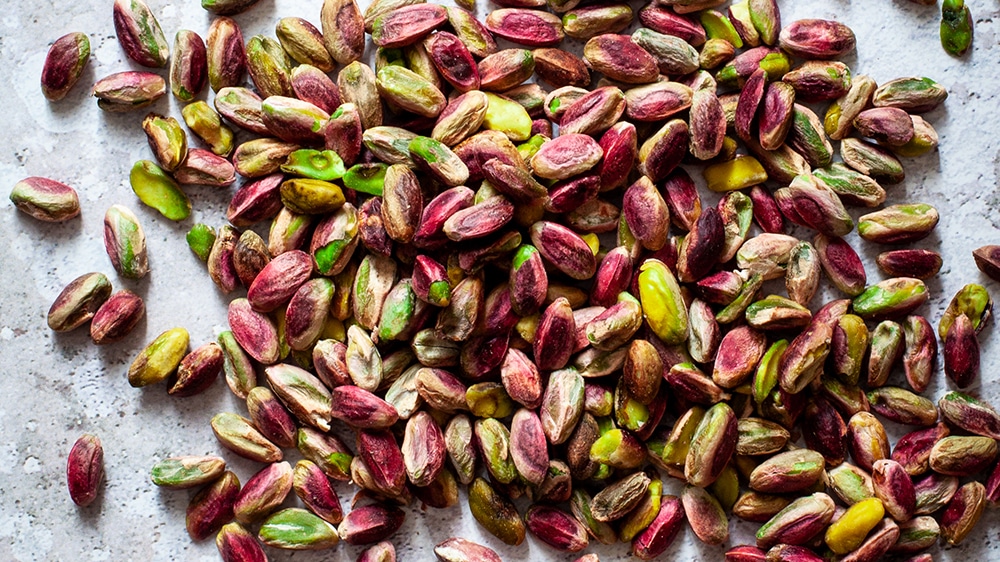
We do eat with our eyes, and if you stop by their stall, you’ll see that a bag of these are an absolute feast: bright purple skins and even brighter chlorophyll-green centres jump straight out of the cellophane. As it happens, that visual treat is echoed in the eating – the moreish flavours of my youth are amplified and emboldened. These pistachios are many times sweeter than my memories, as bright in flavour as they are in colour. Juicy too. Honestly, try them: you’ll immediately see why, in my opinion, you must always have a bag of them to hand.
They’re the ideal store cupboard ingredient, ready to embellish and improve a multitude of dishes, both savoury and sweet. You could, if you wish, chop half a bag finely, stir into honey and layer between sheets and sheets of buttered filo. But I’ve found I’m more likely to use them a few handfuls at a time: scattered over breakfast (yoghurt and fruit, or porridge); as part of a sort-of-gremolata to supercharge simple lunches (Ottolenghi-style crisp or sharp salads, with labneh or mozzarella); stirred into rice or grain-based platters for flavour, crunch and colour alongside dried fruits, fresh herbs and citrus; used in snacks and treats like chocolate bark and brownies; and on creamy desserts too (trifle, panna cotta). A sprinkling of raw, unsalted pistachios punches above its weight and is never superfluous in the way, dare I say it, pomegranate seeds can be.
If you’d like to do a little more than simply chop and scatter, consider the dukkah suggestion below. The spices, sesame seeds and flaked salt bounce so well off the pistachios in this versatile garnish. As with Oliveology’s pistachios, once you’ve tried it, it may well (read: should) become a constant presence on your shelves.
Pistachio dukkah
Put 1 tsp cumin, 2 tsp coriander seeds and 8-10 black peppercorns in a small heavy-bottomed pan and toast gently on a low hob for 3-5 mins until fragrant but not browned. Decant to a pestle and mortar. Add 4 tsp sesame seeds to the pan and toast those for 2-3 mins until golden. Grind the spices to a powder while keeping an eye on the sesame seeds.
Run a knife through 50g raw, unsalted pistachios a number of times until coarsely chopped (not fine or a powder, but not just split into one or two pieces). Add these and 4 tsp sesame seeds to the spices, along with 2 tsp flaky sea salt and, if you want a little kick, 1 tsp Aleppo chilli flakes too. Mix well and store in an airtight container at room temperature until needed. A homemade jar of this Egyptian garnish can be used to add a new dimension to a wide variety of dishes and meals. Dip some great bread first into olive oil and then into the dukkah. Use it to embellish hummus or baba ghanoush-style dips. Sprinkle it over roasted vegetables, honey-vinaigrette greens like green beans or mangetout and sugar snaps, or fresh cheeses like burrata, ricotta, curd. Or scatter it on platters of yoghurt-dressed charred and chopped kale or other leafy salads.
Borough Market: The Knowledge
Discover Borough Market’s stunning new cookbook, full of inspiration and insight, featuring 80-plus recipes by Angela Clutton
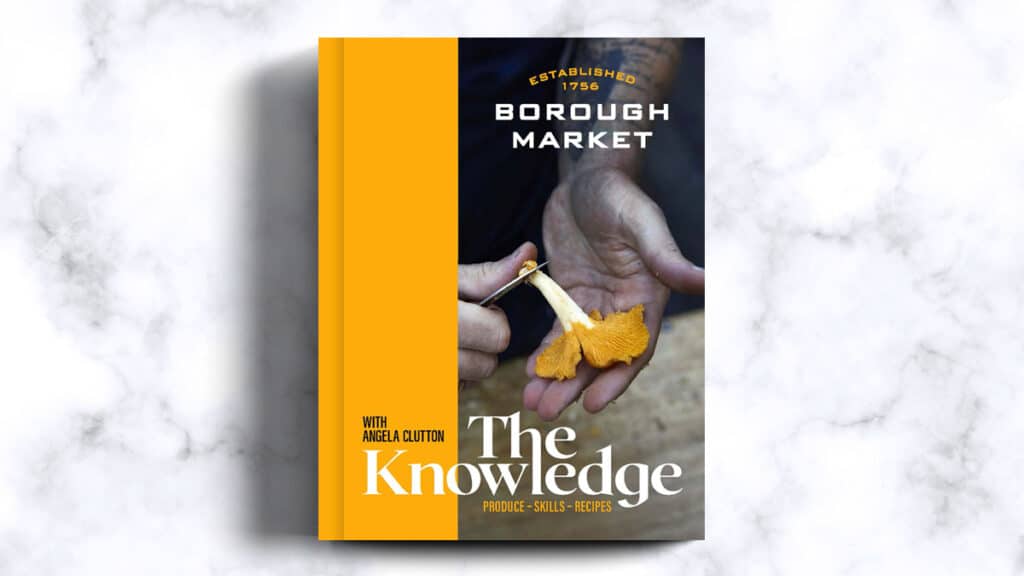

We are very excited to announce the upcoming publication of our new cookbook, Borough Market: The Knowledge. Available from 27 October, the book is rooted in the passion and expertise of the traders who form the beating heart of the Market.
Across eight chapters, each devoted to a different category of stall, from the butchers to the greengrocers to the cheesemongers, that collective knowledge is brought to life through more than 80 recipes by Angela Clutton, award-winning food writer and presenter. With typical warmth and clarity, Angela explores how the traders’ expertise can be brought to bear in turning Market produce into stunning dishes. The book also distils their wisdom into features, interviews, tips and guides that demystify unfamiliar ingredients and processes, and explains not just what to buy (and why) but how to store it, cook it and serve it.
Recipes include:
— Roasted Cod’s Head with Clams and Seaweed
— Beef, Leek and Ale Pie
— Parsnip Gnocchi and Smoked Garlic Butter
— Moong Dal Dosa with Masala Potatoes and Tomato Chutney
— Jasmine Tea Loaf with Salted Lime Butter
— Ginger and Pink Peppercorn Baked Cheesecake.
Borough Market: The Knowledge, beautifully photographed by Kim Lightbody, is the third Borough Market book to be published by Hodder & Stoughton, following the success of The Borough Market Cookbook and Borough Market: Edible Histories. It is available now for pre-order.
Q&A: Elizabeth Haigh
The chef-owner of Mei Mei on Singaporean cuisine, ‘kopitiam’ culture and the importance of measuring from the heart
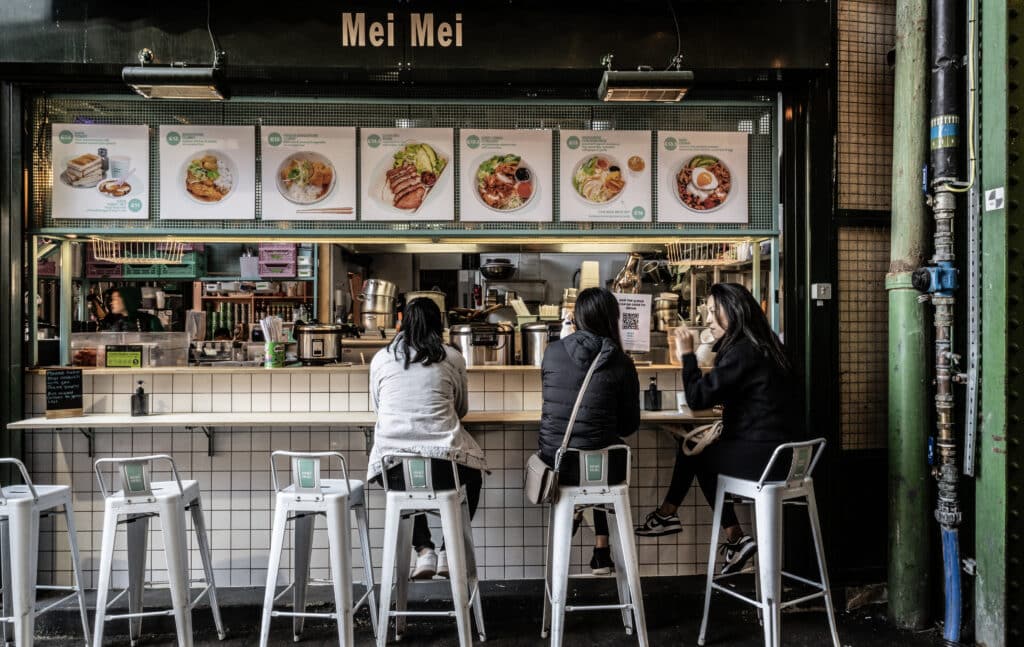

“THE BEST THING ABOUT THE FOOD FROM SINGAPORE IS THAT IT’S A COMBINATION OF MANY DIFFERENT CULTURES”
Interview: Ellie Costigan / Portrait: Steele Haigh
Elizabeth Haigh established herself as a chef to watch back in 2011, when she competed on MasterChef aged just 24. As its inaugural head chef, she helped east London restaurant Pidgin win a Michelin star, before setting out on her own with a mission to bring her heritage Singaporean cuisine to the masses. “There are not enough Singaporean-Malaysian restaurants,” she says. “Everyone can name a Chinese restaurant, an Indian restaurant, a Vietnamese restaurant in London. How many Singaporean restaurants can people name? Not enough. Representation matters.” Mei Mei is her answer to that shortage: a Singaporean ‘kopitiam’ in Borough Market Kitchen.
What’s your strongest early memory of food?
As far back as I can remember, we would eat round the dinner table together as a family. We would be eating so quickly and hastily that we wouldn’t be having a conversation, but it was just the nicest thing – being with my family, having this tradition every night. We would usually eat quite late, because my mum worked late, but she would always prepare fresh food. It’s something I’m trying to continue with Riley, my son. There’s a lot of distractions now – TV, YouTube – so I really push the importance of having that time together.
You say that there’s no such thing as ‘typical’ Singaporean cuisine. What defines it for you personally?
It’s like trying to define what London food is: you can’t. The best thing about the food from Singapore – and London – is that it’s a combination of many different cultures. Everyone brings their own influences and knowledge. What I love about being in Singapore and the cuisine there is that there’s an undeniable respect for everyone’s background.
Something that’s definitely common, though, is chilli – we’re not talking blow-your-socks-off chilli, but heat. There are a lot of aromatic ingredients such as lemongrass and galangal – that’s very common in all the food right across the country. Galangal is called blue ginger back home. It’s as aromatic as lemongrass but with slightly more fragrant notes. It’s distinctive to our cooking. As is pandan, a leafy green with a unique flavour profile – savoury and sweet at the same time. It’s a key ingredient in the Hainanese chicken rice. There’s also never enough garlic in a Singaporean’s eyes.
When did you discover your passion for cooking?
My mum never let me cook at home. I studied architecture at university, so it was 18-hour days studying, working from home mostly. Before that, if I was feeling a bit down my mum would always say: “Let me make you that herbal soup that makes you feel better.” I found I was really lacking that instant comfort and the luxury of someone cooking for me. I tried to recreate some of the dishes, but I just didn’t have the knowledge and didn’t have access to the ingredients, even though I was in London. I’d go into Chinese supermarkets and think, what is all this?! I don’t know what any of these things are. I would pester her on the phone: “Mum, how do I make that crispy roast pork?” She’d say: “You just prick the skin, put it in the oven and cook it.” I’d be like, there’s probably a bit more to that?!
For her, it’s second nature, so to ask her to quantify things was so hard. There’s a Malaysian phrase, ‘agak agak’, which means ‘your ancestors will tell you when it’s enough’, so basically measuring from the heart. Jamie Oliver westernised it with a swish of this, a slosh of that – it’s the same with our cooking. It’s about going with your gut. That’s what my mum was trying to teach me.

How accurately do the dishes at Mei Mei reflect your mother’s recipes?
We don’t try to recreate them, but we treat the recipes with respect. It’s not going to be authentic, because we use chickens from here in the UK, not ‘kampung’ chickens, which means village chickens. We don’t use the same lemongrass and chilli – the chillies over there are vastly different from the Dutch chillies we have here. Even the lemongrass and galangal – everything is a lot fresher there, because obviously these things have to travel to get to the UK. We try to adapt it so that it works in Britain, while being respectful of tradition. I think we have achieved it, because we do get a lot of people telling us our food reminds them of home. We had a customer here last night for dinner who said: “That barbecue makes me feel like I’m back in the hawker.” That’s exactly what we wanted.
How did you go from training to be an architect to becoming a chef?
I did four years of my architecture course before I realised I wasn’t entirely happy. I was spending all my time in the kitchen cooking and watching MasterChef, and I just felt more satisfied doing that than I did studying or working in the studio. My friend dared me to apply for MasterChef and I got on. I did well in it – or well enough, I didn’t win it – and I enjoyed being around people who were likeminded about food. People of all ages, all with that similar passion. I’d never considered a career in cooking until then, because I was pushed into the university route. I wish I’d had the guts to follow my true passion.
I’m more of an artist, so the design and creative process of architecture really fascinated me and I think that translated easily to being a chef. There’s also a lot of time management, money management, people management – you need to understand people, listen to customers and clients, so becoming a chef wasn’t too hard a transition. The hardest thing was giving up evenings and weekends, birthdays, holidays, weddings. Everything. Your social life, basically. But in exchange I I’ve gained all this invaluable knowledge and skill. It was important to me to start my own business so I could pass on that knowledge.
Did you always want to open your own restaurant?
When I left Pidgin, I wanted to open a restaurant. I had many failed attempts – it’s a lot harder than you might think. But we’ve always wanted a restaurant and I had a very distinct vision of what it should be. I wanted to have an open plan kitchen, so you could see all the chefs cooking, working away. It’s a very visual thing. It feels like you’re in a hawker – or kopitiam, as I say.
Tell us more about the kopitiam concept. What’s the cultural significance?
Kopitiams and hawkers are literally all over Singapore and they run day and night. ‘Kopi’ is coffee, ‘tiam’ is shop. Kopitiam; coffee shop. They are integral to the culture of Singapore. In every community, in every area, you will have a kopitiam. I will go down in the morning in my vest and slippers, have my teh tarik, order my kaya toast – both of which we serve at Mei Mei – and sit there. No one will interrupt you. The aunties and uncles will be chatting happily. One thing to know about Singaporeans is, we are loud. Very loud.
In Singapore, you will go out for breakfast, lunch, dinner, supper, tea, elevenses – rarely will people eat in or cook at home, unless you have an au pair or a grandmother who cooks, because it’s so affordable to eat out. You start off in a kopitiam and then you might go to a hawker, which is a little collection of stands, each of which specialises in one dish. Maybe in one hawker there will be an uncle that does the best coffee. Next door to him there’ll be the best fish ball noodles. Next door to him will be a spot that does the best barbecue stingray and satays – a giant open charcoal barbecue with racks of food. They will be masters of those recipes because all they focus on is doing that one dish. They’ll put in 10,000 hours to master it.
What would you say is Mei Mei’s hero dish?
We specialise in Hainanese chicken rice – that’s our hero dish and it’s one of Singapore’s national dishes. It’s also the one dish I can eat at any time of the day and not be sick of. We’ve been here nearly two years and I’m still eating it every day. It’s very nourishing: chicken poached lightly, served cold but you have a hot soup with it, so it works well in winter and summer, then you have the spicy chilli to wake you up. Rice is the most important bit. It’s cooked in the chicken broth and fat with ginger and garlic. We like to think we’ve put our 10,000 hours into that dish. Definitely 10,000 chickens!
Blessed are the cheesemakers: feta
Clare Finney tells the story behind a tangy, sweet and salty cheese from Borough Cheese Company
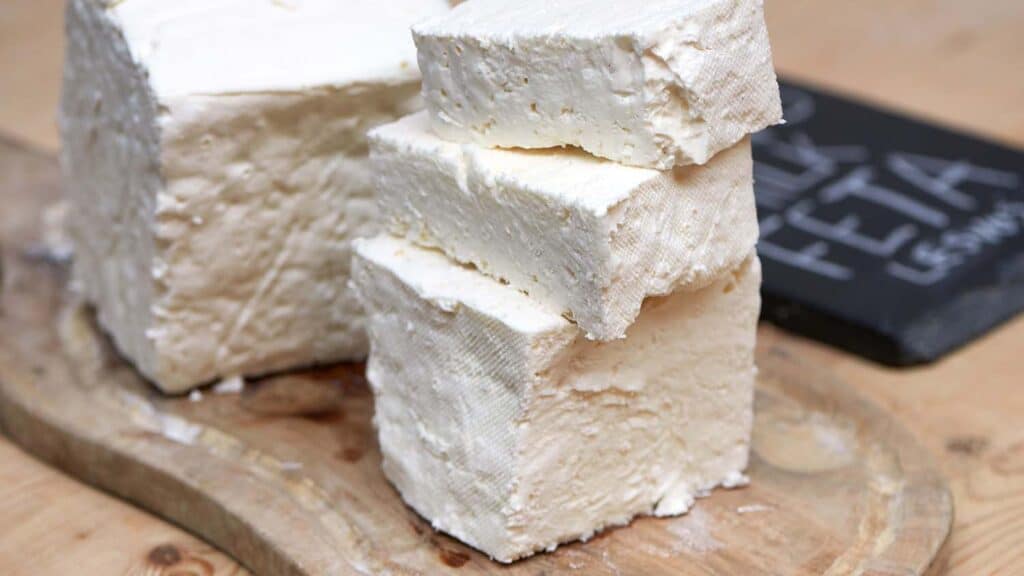

“THE GEOLOGY AND SEASHORE SETTING OF LESBOS CREATE THE PERFECT FOLIAGE FOR PRODUCING QUALITY MILK AND CHEESE”
Should you ever be so lucky as to find yourself sailing around the Greek island of Lesbos, keep your eyes peeled for a boat full of sheep, manned by a shepherd. It shouldn’t be hard to miss. They’ll be heading to a small island of volcanic rock across the bay to supplement their diet with its unique varieties of mineral-rich herbs. The sheep are a hardy breed, native to the island, and they graze outside throughout the seasons – “not that winter is ever that bad here, but it can get cold in the mountains,” says Dominic Coyte of Borough Cheese Company. “In the summer months they have to find shelter during the heat of the day, and graze evenings and mornings.”
Being one of only a handful of Greek feta cheeses to hold protected designation of origin (PDO) status, the feta of Lesbos is invariably better and certainly more reliable than commercially produced iterations. The island’s geology – “the area producing feta sits on a caldera, which is essentially a volcano that has collapsed on itself” – and seashore setting makes for the perfect foliage for producing quality milk and cheese. “Much is made of the minerality of the Agra area, where our feta is produced, and the benefits to the herbage. There are no olive trees” – the roots of which make for quite bitter milk, if the sheep eat them – “and a real diversity of shrubs, herbs and wild flowers,” says Dominic.
Though best known for his mountain cheese, in recent years Dominic has been alternating mont d’Or, his venerable winter cheese, with this delicate, summery Greek number – its tangy, sweet and salty strains just crying out for fresh cucumber, black olives and tomatoes.
“Our feta is produced by the Tastanis family, who have been making cheese in this area for three generations,” says Dominic. They work with 15 shepherds and 1,500 sheep to produce feta from December to July. Three months ago, he went to visit them and was fed feta on every possible occasion. “We had about 20 courses and each had feta: with fish, wrapped in pastry, warm, cold… it just showed how versatile it is as an ingredient.” Though the majority of feta are a mix of sheep’s and goat’s milk, the Tastanis family make theirs with 100 per cent sheep’s – “so it has a very smooth texture, which is unusual in feta. What I like about the cheese is, that salty sharpness is not so obvious, so slightly fruity flavours can come out in the background.”
The sheep are milked twice a day. “It’s very impressive. Sixty per cent of the herd are milked by hand: I remember this guy sitting on an upturned bucket being jostled by sheep as he quickly milked each one.” The milk is taken to the dairy that morning and again in the evening, filtered, pasteurised and made into cheese. The Tastanis use their own yoghurt to culture the milk. “The most significant thing about feta is the use of salt: dry salting the curd and ageing it in brine,” Dominic explains. Feta varies hugely between regions and producers, but the method doesn’t vary much up until this point. What happens next – how long it matures for and whether that maturation takes place in metal or a wooden barrel – is at the discretion of the maker and seller. “Ours is six months, but it could go a little longer, over which time it will get slightly denser and saltier. I think if you capture it around the six to 10 months mark, it’s perfect,” he continues. “You have that creamy deliciousness. You have that blend of flavours.” You have a cheese savoury enough for a spanakopita, sweet enough for watermelon, rich enough for a salad and creamy enough for our personal favourite: a slice of sourdough toast and a drizzle of Oliveology’s Greek honey.
Shell shock
Thom Eagle on why the bold flavours of native brown crab mean that, rather than being treated with the delicacy afforded to lobster, it can provide the basis for a more adventurous style of cooking
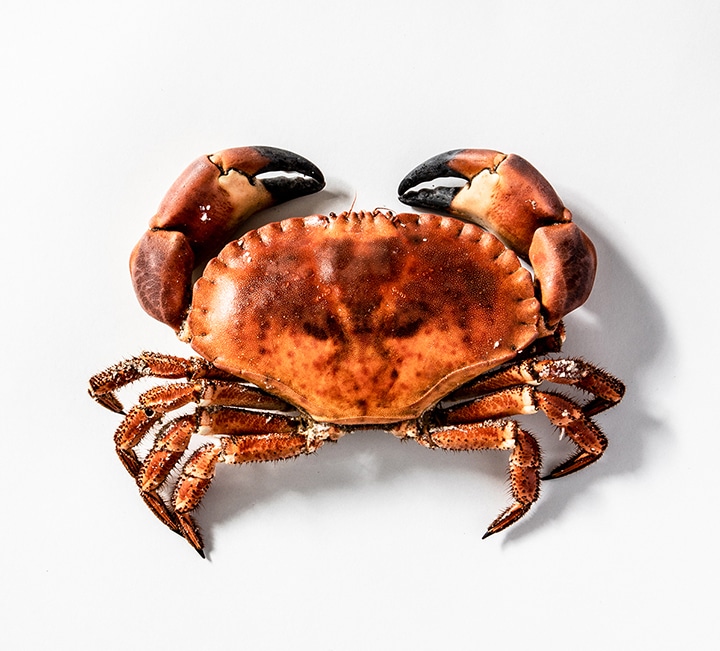

“GET YOURSELF A FEW BOTTLES OF RIESLING AND SOME WHOLE CRABS AND MAKE A DAY OF IT”
Images: Regula Ysewijn
I lived for many years in Norfolk, mainly in Norwich, and particularly there and in the north of the county, all the way from Yarmouth to the Cromer sands, nothing heralds the start of the culinary summer so much as the arrival on the menu and market stalls of crab. In a world where few things still seem to be local and seasonal, where the great herring fisheries have long since moved on and where even Colman’s mustard, until recently the pride of Norwich, has relocated its factories, the Cromer crab is still very much a going concern, available during the season in every cafe and restaurant east of the Wash. Although the people of Cromer are right to be proud of their local crustaceans, really they are good all over the country, if often compared unfavourably with the apparently more glamorous lobster.
In defence of the crab, Hugh Fearnley-Whittingstall has made the remark that while lobsters cost twice as much as crab, they are not twice as delicious – which is true. Even this misses the point, though, which is that crab is in fact a very different eating experience to lobster, and not really to be compared at all. Bisques and ravioli notwithstanding, the somewhat ephemeral taste of lobster is to my mind best enjoyed as-is, halved and in the shell, with only a flavoured butter of some sort (garlic, usually) to adorn its sweetness – the kind of meal best seasoned by the close proximity of seawater. Crab, it’s true, is often served like this as well. Order a crab salad at, say, Cookie’s Crab Shop on the north Norfolk coast and you will get not a mixed affair but rather a selection of salad items alongside a whole dressed crab – a crab that has been boiled, cracked open, picked over and packed back into the shell.
While nice once in a while, I think this is in general simply too much crab to eat. To me, the strong flavours of both the sweet white meat and the murkier brown really come into their own when combined with other things.
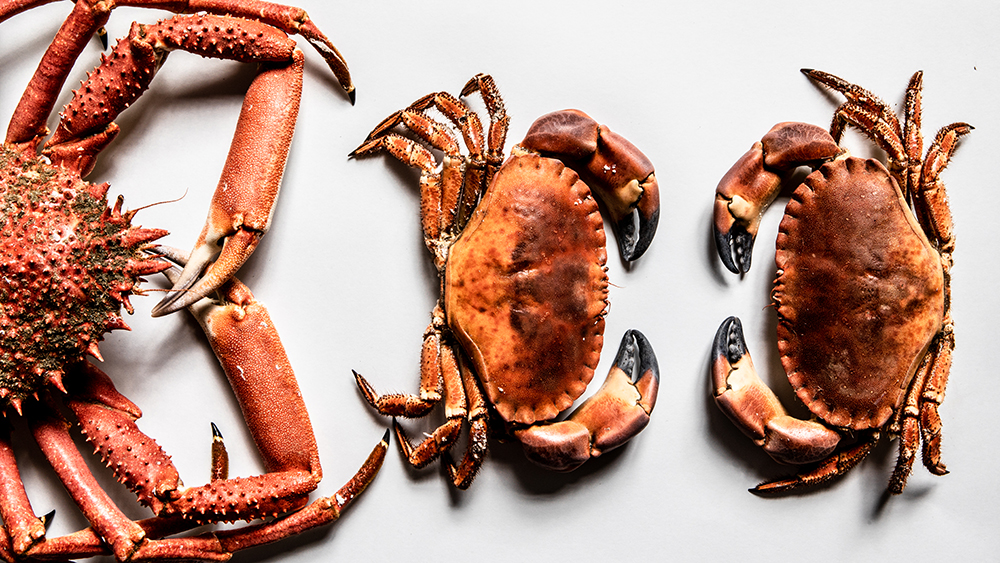
The white meat, from the legs and the fat claws, is essentially the muscle meat of the animal (insofar as a crab can be said to have such a thing), while the brown, composed of not-yet-formed shell and the various organs inside the main body, is crab offal by another name, and the same sort of hierarchy between the two exists as in the meat of any other animals. When I was cooking at Little Duck, lacking the time and the space to really get to grips with a crab, we would buy tubs of either white or brown meat, the former being more than three times as expensive.
As, again, with the cheaper cuts of meat, this distinction is a blessing for those who like deeper flavours; less sweet and delicate, the brinier brown meat is doubly economical, as a little goes quite a long way. Just a tablespoon or two, loosened with a splash of the cooking water, seasoned with some garlic and chilli just-tempered in oil and brightened with a squeeze of lemon juice, makes a wonderful sauce for thick spaghetti; or stir the same amount through a risotto with fresh peas for something that feels like a Venetian spring. The classic treatment, of course, is just to mix it through some mayonnaise and spread it on toast.
Even the less pungent white meat can be happily stretched further with a little thought. A good option is to pair it with something similar in texture, sweetness, or both. At The Sportsman in Kent, Stephen Harris serves white crab meat with hollandaise sauce and a little shredded carrot, the texture of which exactly matches the just-cooked crab. Eating this was the first time crab really made sense to me, its flavour distinct and exact.
At the restaurant, we used to make a sort of crab soup with sweetcorn and fideos, the little lengths of angel-hair pasta. With brown meat as well as the white stirred through, it was hard to tell what was pasta and what was crab, and the result was a very satisfying plateful. More recently I have cooked firm green courgettes with red spring onions and a little garlic in olive oil and their own juices, sweated together until bright and glossy, but with a good bite still to them, and then mixed the result with mint, white crab meat, and sliced lemons preserved under oil, sweet and green and sunny.
These, like the neatly dressed shells sold by the fishmonger, are all very convenient things to do with a crab, but sometimes convenience is not what you are after. Sometimes (not often enough), lunch is something that takes a very long time, and results in a great deal of mess. If you find that this is to be the case, then absolutely the best thing you can do is to get yourself a few bottles of riesling and some whole crabs – one of each between two should be enough, at lunchtime – and make a day of it. Any good fishmonger or market stall, including those at Borough, will be able to supply you with whole crabs. In some cases, if you are adventurous, you might get them live, from which state they will need, for kindness’s sake, to be swiftly despatched, and then to be just as swiftly cooked as once dead, crab does not like to hang around. I won’t, in any case, go into the details here – you can look up the process elsewhere, if you feel up to it. Whether you buy your crabs alive or cooked, however, you will need the same accompaniments. Crab-crackers and picks if you have them, a couple of hammers and a pack of skewers if you don’t; a bowl of mayonnaise, another of lemon halves, and your best friends. You can clean up tomorrow.
Discover more
Edible histories: cider
Mark Riddaway, author of Borough Market: Edible Histories, tells the surprising story of one of Britain’s national drinks
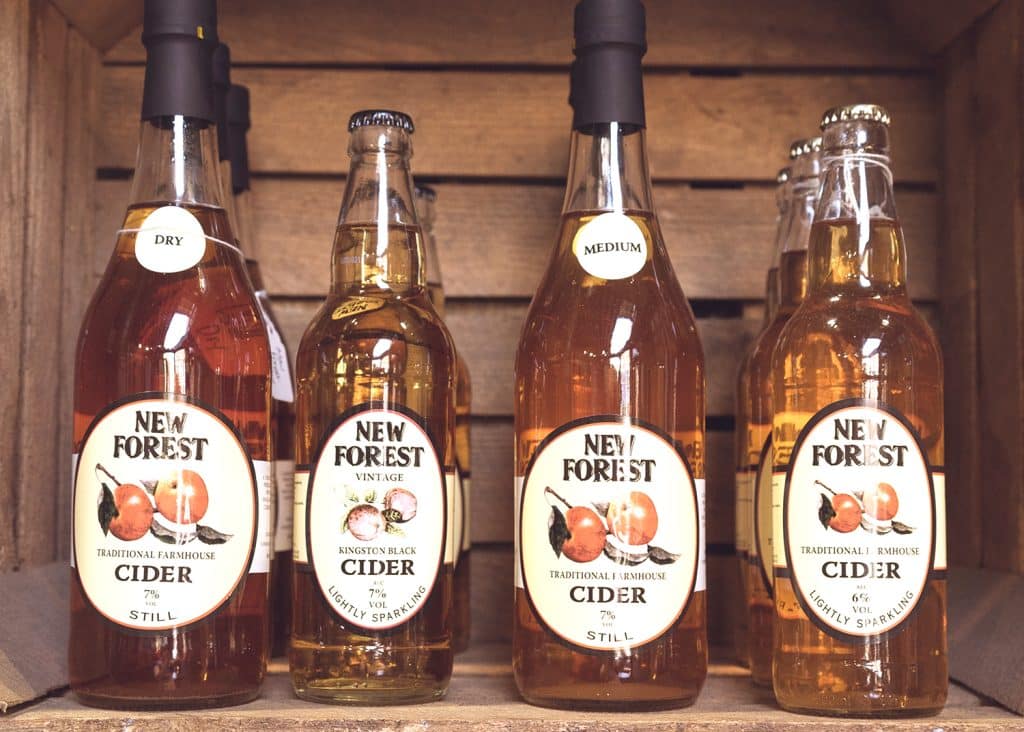

“ENGLISH CIDERMAKERS’ EXPERIMENTS WITH ENCOURAGING FIZZ WERE ADAPTED BY THE CREATORS OF CHAMPAGNE”
Such is its simplicity (being nothing more than pure apple juice, left to ferment), it is easy to presume of cider that it must be a remnant of our misty past – the refreshing draught a Neolithic Briton would have supped upon after a hard day erecting megaliths. The relative brevity of its story may be something of a surprise, then – until you think for a moment about the form of an apple: the tight skin, the sinewy core, the dense, tense web of cellulose and pectin that provides its signature crunch. This is not a fruit that surrenders its juice easily. Even the crushing or milling of an apple, itself a labour-intensive task, is only half the job, with the resulting pulp then requiring a hard and heavy pressing. No doubt, apples have at various times been bashed with crude tools in the pursuit of inebriation, but when it comes to getting the party started, nature offers some far less tiring options.
Certainly, if the ancients were routinely making cider, they left very little evidence. One of the earliest references to the drink came from the Roman writer Pliny the Elder, whose tone suggested it was of minimal importance to his contemporaries. In a chapter of The Natural History (77-79AD), he described 66 varieties of “artificial wine”, including drinks made “of the pods of the Syrian carob, of pears, and of all kinds of apples”. No further insight was offered into this apple wine – in fact, more of Pliny’s words were devoted to booze “made of the naphew turnip”.
It wasn’t until the early medieval period, in northern France, that cider visibly overtook turnip hooch in the pantheon of drinks. Compelling evidence of this came in De Villis, a management manual for the royal estates of Charlemagne, king of the Franks (768-814). This required that “siceratores” (makers of booze) be employed to create “pomatium” (cider), “pyratium” (perry) and other liquors. That Europe’s wealthiest monarch was making cider was telling: it was the development of the screw press that made its preparation viable (as well as transforming the speed of wine and olive oil production), but constructing a screw press was an expensive business. While the humblest of households could brew beer, only the rich could afford to make cider, and even then its production was usually a secondary pursuit: those abbeys and aristocratic estates that made wine in the summer used the same costly presses to juice apples in the winter.
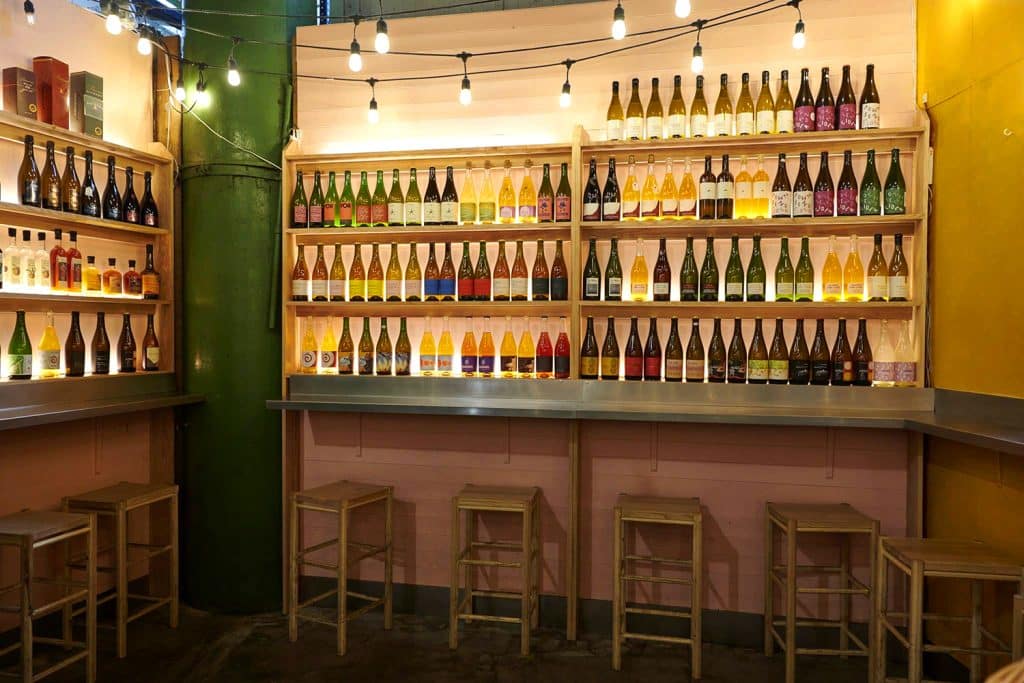
It is often said that the Norman conquest brought cider to England, but evidence of the drink being brewed here only really began to emerge in the 13th century. Over the two centuries that followed, occasional references to mills, presses and cider sales began appearing in estate records, but it was only after 1400 that the dam broke and the scrumpy began to flow. This move from the margins was closely linked to the progress of enclosure: the transformation of the English countryside from a system of vast, unfenced common fields, narrow strips of which were tended to by individual peasant families, to one dominated by larger farms. Orchards, which had no place in the old open field system, became a viable option for yeoman farmers, and hence, too, did the production of cider.
This was particularly true in the west of England. In the counties of the southeast, the flat landscapes and light soils lent themselves to intensive arable farming, but in the wet and rugged westerly regions, where cereals flourished less readily, apple trees and livestock offered a complementary combination: trees provided shelter, and the pomace from cider making – the mulch left behind after pressing – could be used as feed. As presses and mills became more readily available, Devon, Somerset, Gloucestershire and particularly Herefordshire became centres of English cider making. One of the major destinations for this cider was the region’s ports, to be used in sailor’s rations. John Parkinson wrote in 1629: “In the West Country of England great quantities, yea many hogsheads and tunnes full are made, especially to bee carried to the sea in long voyages.”
The 17th and 18th centuries were a golden age of English cider making, chronicled and partly inspired by a group of self-described ‘ciderists’: intellectuals who loved cider, believed that its quality could be improved by embracing a spirit of rational inquiry, and aimed to embed it as our national drink. Two ciderists, John Beale and John Evelyn, were founder-members of the Royal Society when it was established in 1662, making the link between scrumpy drinking and Enlightenment thinking much clearer than might be expected.
The ciderists’ ideas were set out in Pomona (1664) – part polemic, part practical guide – which was prefaced and compiled by Evelyn but built around the horticultural knowhow of Beale. Their hope was to “redeem” cider from the “opinions of those men who so much magnifie the juice of the grape above it,” wrote Evelyn, who argued that English tastes are “generally more for insipid, luscious, or gross diet, than for the spicy, poignant, oylie, and highly relish’d”, and that cider, unlike wine, was a natural fit for the native palate. As evidence, he told the story of a Mr Taylor, “a person well known in Herefordshire”, who had challenged a London vintner to put his best “Spanish or French wine” up against his county’s cider in a series of increasingly rigorous taste tests, every one of which ended in victory for the West Country draught.
As Pomona made clear, fundamental to the boom in English cider making was the cultivation of distinct local varieties of cider apple, known collectively as bittersweets and bittersharps. Beale’s cousin, Viscount Scudamore, was credited with propagating the most famous Herefordshire bittersweet, the redstreak. Cider made with its juice would, wrote Beale, “excel common cider, as the grape of frontignac, canary, or baccharach, excels the common French grape”. It had, according to Captain Sylas Taylor, another ciderist, “the flavour or perfume of excellent peaches, very grateful to the palate and stomach”. Other acclaimed varieties included the gennet moyle, which resulted in cider “of smaller body… yet very pleasant” and the summer fillet and winter fillet, which “passed for white wine” and when mingled with syrup of raspberries made “an excellent woman’s wine”.
Demand for good quality cider was inflated by a series of conflicts with France that led to French imports, including wine, being either scarce or embargoed (the ciderists’ aim was, in Beale’s word, to relieve “the want of wine, by a succedaneum of cider”). The best cider was made with the first runnings of the press, then racked from one cask to another (a process known as ‘keeving’) to inhibit yeast build-up and slow the fermentation, which improved its flavour. The sweetness (and strength) of the cider could also be increased by ‘tumping’ the apples – leaving them to age outdoors for several weeks – or, still better, keeping them in an indoor drying loft. Bottling the cider, a new notion, also added to its appeal. In 1615, when a timber shortage led to a ban on charcoal furnaces, glassmakers were forced to start using coal, which burns much hotter, and the glass that emerged was far sturdier than the delicate stuff of old – sturdy enough to withstand the pressure of a secondary fermentation, resulting in a lightly sparkling drink. It was English cidermakers who first experimented with encouraging effervescence in their bottles – innovations that would later be adapted by the creators of champagne.
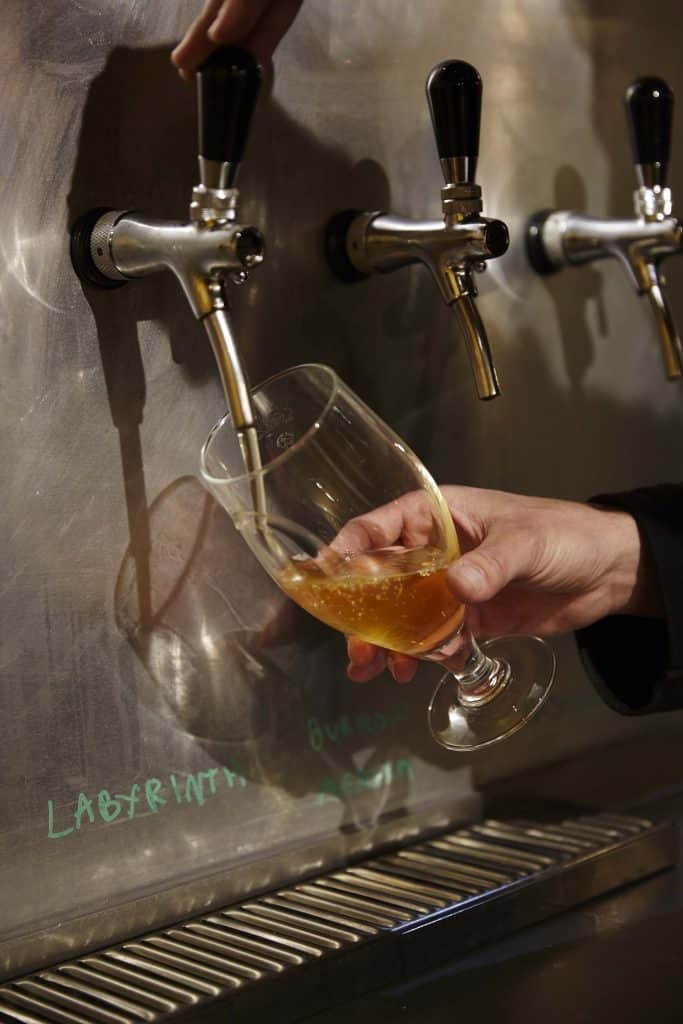
Posh cider was far from the only game in town. Hugh Stafford, in his Treatise on Cyder-making (1753), made a distinction between fine cider and “rough” cider, with the production of the latter requiring far less time and care than the former, making it more widely affordable – it was this rough cider that became a staple of public houses around the country. At the bottom of the scale was “an agreeable liquor, for common use, call’d water-cyder”. Also known as ‘cider-kin’, this was made by soaking the pomace in water, then pressing it one last time, the ferment of which produced an insipid, lightly alcoholic drink. This was often fed to farmworkers in lieu of actual wages – a practice known as ‘truck’, which remained common in the cider regions until it was banned in the late 19th century. “This the peasants blithe / Will quaff, and whistle as thy tinkling team / They drive and sing of Fusca’s radiant eyes,” wrote the poet John Philips in his Cider: A Poem in Two Books (1708), an epic paean, written in the style of John Milton’s Paradise Lost.
Despite its ability to elicit raptures from poets, English cider was destined to be a victim of its own success. Increased demand led to the arrival in the marketplace of cider merchants whose nose for a profit led to all kinds of dilutions and adulterations. Its reputation was damaged further by the 18th century outbreak of ‘Devonshire colic’, an illness attributed to cider but later found to be lead poisoning. Mostly, though, it was killed by the rapid expansion of the beer industry, which quickly out-stripped the largely farmhouse-based world of cider in its range and sophistication. Cider making entered a death spiral, with reduced profits leading to farmers turning their orchards over to other uses. The most prized cider apples, the fabled redstreak included, gradually lost their disease resistance, but a stagnant industry failed to cultivate replacements. In 1785, the agricultural writer William Marshall decried how “all the old types that raised the fame of the liquors of this country, are so far in decline as to be deemed irrecoverable.”
It wasn’t until the late 19th century that a partial revival was triggered, inspired in part by developments in one of the drink’s other great heartlands: northern France. In the 1860s, when their grapevines were ravaged by the phylloxera louse, French authorities had been persuaded to finance a significant survey of and investment in the region’s cider making capacity. This sparked considerable interest among a group of Herefordshire naturalists who began experimenting with French apple grafts and working with some success to bring the county’s orchards back to life.
However, the real spark for the resurgence of cider was lit not in its western hub but in East Anglia, previously a relative backwater (one survey of Norfolk from 1796 had famously concluded: “Orchards very few, and much neglected, consequently no cider”). In 1870, William Gaymer, a Norfolk cidermaker, invested in a hydraulic press and began building a national brand, creating a system of cider making based around factories rather than barns. Gaymer helped break the link between grower and manufacturer by buying in apples from far and wide: in 1903, when the Norfolk apple crop failed, supplies were brought in from Devon. Others followed his lead: Percy Bulmer opened a factory in Hereford in 1887 and proved just as innovative in his embrace of industrial ideas.
Farmhouse cider, and the regional distinctiveness that came from the use of single varietals, became a niche drink as the big factories gradually took over. In the second half of the 20th century, cider became a pasteurised, filtered, carbonated, mass market product, largely made from anonymous apple concentrate, much of it imported. In recent decades, industry ‘innovation’ has seen the creation of white cider: a strong, colourless brew made by adding glucose or corn syrup to pomace – think of it as a weaponised version of cider-kin.
The idea of cider as a beautiful, simple, natural drink with a strong local character never entirely died out, though, as a visit to The London Cider House at Borough Market will make immediately clear. As John Philips would say, could he see the stall: “Thy choice Nectar, on which always waits / Laughter, and Sport, and care-beguiling Wit, / And Friendship, chief Delight of Human Life. What should we wish for more?”
Borough Market: Edible Histories by Mark Riddaway (Hodder & Stoughton) is available now from The Borough Market Store, in bookshops and online.
Bringing home the bacon
Two of Borough Market’s butchers share the secrets of producing, choosing and cooking the perfect bacon
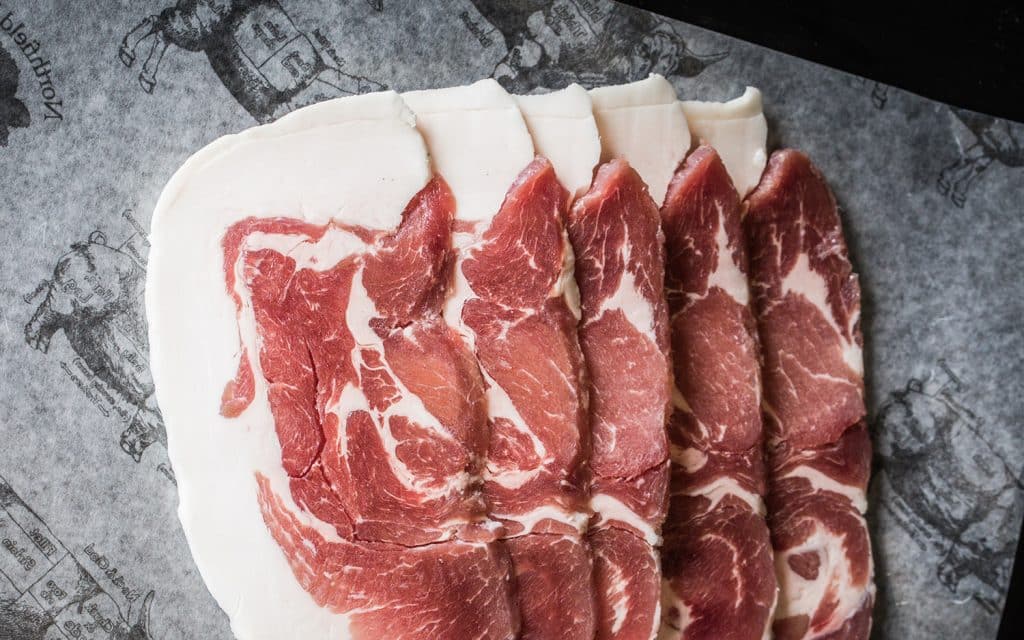

“COLLAR BACON, FROM THE SHOULDER OF THE PIG, IS THE VELVET UNDERGROUND OF BACON: IT HAS A CULT FOLLOWING”
Words: Ellie Costigan
It’s hard to find someone who eats meat who doesn’t love bacon – in fact, the same can be said for a fair few people who aspire to vegetarianism. There’s just something about the salty, savoury flavour and crunch of those crispy edges that hard to resist. Most of us will agree that bacon is one of the best things to come from the butcher but like many crafts, it has a simple process at its heart. “There are several different types of bacon: loin, belly, streaky and middle,” says Jozef at Ginger Pig. “Whatever the type, the most important thing is, you have to begin with really good quality pork – that is where the flavour comes from.”
The pork joints arrive fresh from the farm with the bone still in. Once deboned and ready for curing, the team apply a mix of dry curing salt and brown sugar. “We don’t use all that much cure – somewhere between two to three grams per kilo of pork. It’s there to enhance, not mask, the pork’s flavour. We rub this on the meat and then dry cure it for a week, turning the joints over every other day. When we’re happy with the level of cure, the salt mixture is washed off and the joint is then air dried for two weeks.”
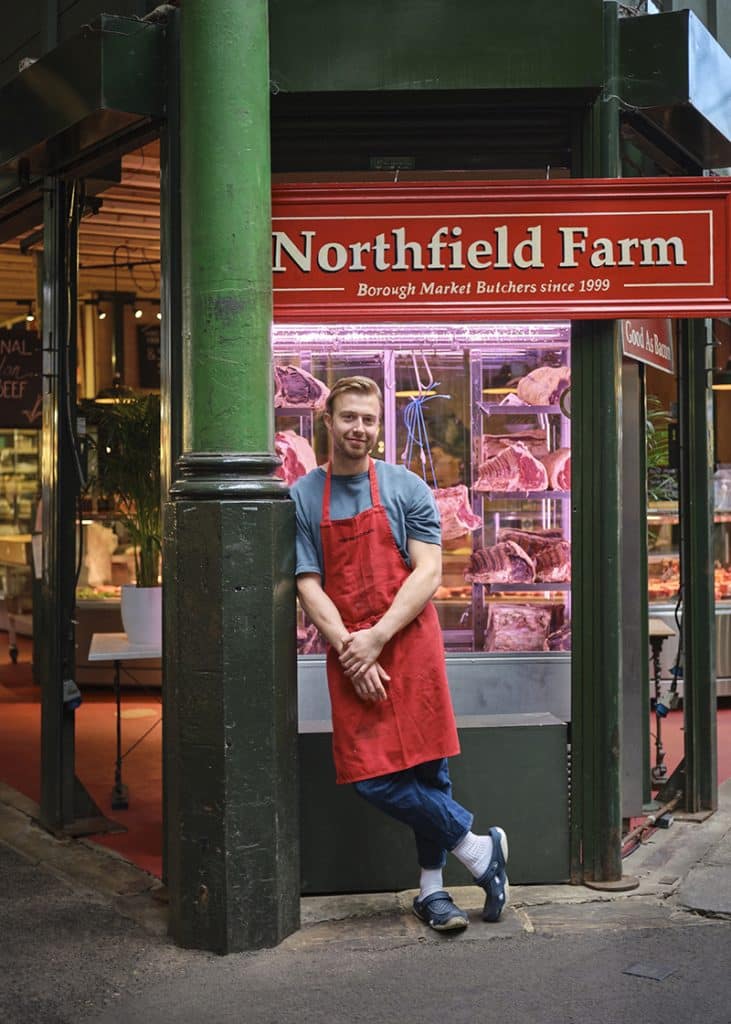
At this point, some are sold as unsmoked bacon; the rest have a few more steps to undergo. Joints can be single, double or triple smoked, depending on the end flavour the team are looking for. They can also take things in different flavour directions, as with their treacle bacon. “For that, we start by using curing salt without sugar, then we rub black treacle over the joints and air dry for at least two weeks. It is delicious.”
When it comes to cooking, Jozef says, “if you use a great quality bacon made from high quality pork it does not really matter what you do with it.” His personal preference is to cook it in an oven on a low heat for 15 minutes, then whack the heat to high for the last two to three minutes. “That gives you crispy edges and lovely succulent meat.”
Dom from Northfield Farm – which sources mostly outdoor-bred British lop from neighbouring farmers up in Leicestershire – agrees. “If you start with really good bacon, you won’t go far wrong. The pork will do most of the work for you.” But he suggests breaking out of the habit of buying your favourite type of bacon all the time. “Firstly, the fact that different types of bacon come from different parts of the animal means the meat has different properties. Then there are different curing mixtures and methods. There are lots of different textures and flavours to explore.”
HIs favourite is collar bacon, “which comes from the shoulder of the pig and is one of the fattiest areas of the animal,” he explains. “Also, because it comes from a hard-working area, you get a rich meaty flavour – a bit more savoury than other bacon. It is densely marbled and does not really have an ‘eye’. That fat really helps bring out the flavour.” Northfield Farm has been selling it as long as they have been here at Borough Market. “I call it the Velvet Underground of bacon: it has a bit of a cult following,” he says with a laugh. “Not everyone knows about it, but those who do really love it.” When it comes to cooking, Dom favours a screaming hot frying pan. “That way you get nice crispy edges, succulent meat and you don’t render out all of that delicious fat.”
